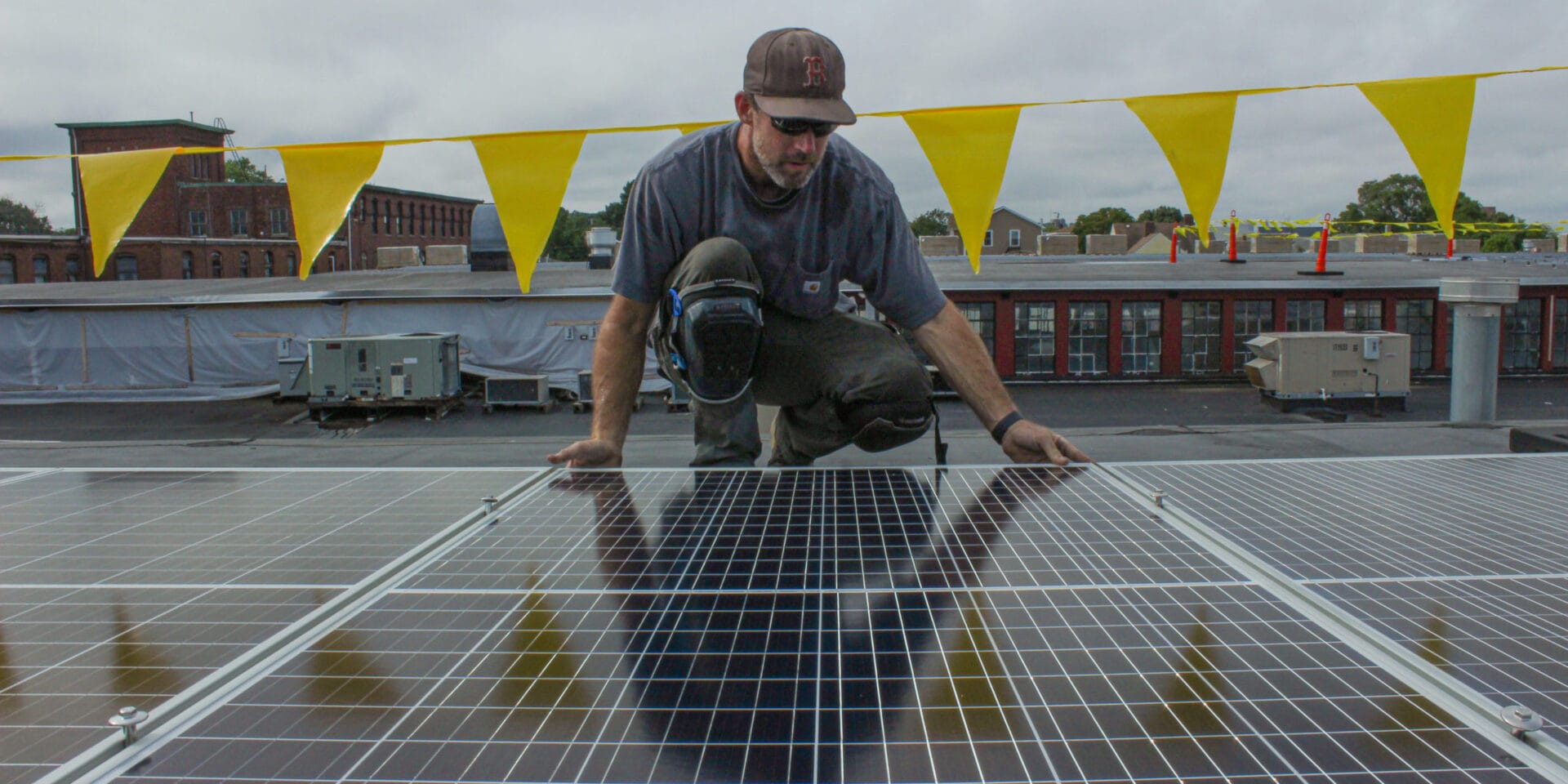
Solar News Stream of Conciousness
Massachusetts low income housing solar programs
$250 million in funding from the Environmental Protection Agency’s $7 billion Solar For All program
$65 million of the total is earmarked for affordable housing communities
EPA is expected to announce award decisions in March 2024
Massachusetts Solar Technical Assistance Retrofit (STAR) program provides technical and financial assistance for affordable housing organizations to adopt solar
analyzed the portfolios of 44 affordable housing providers, encompassing more than 1,700 buildings
affordable housing providers have installed or committed to a cumulative 7.9 MW of solar across nearly 200 rooftops
projects represent more than $30 million in lifetime savings for the housing owners and reduce carbon emissions
STAR program supports housing providers in filing for tax credits created by the Inflation Reduction Act. Last fall, Resonant Energy helped clients submit 102 applications to the Department of Energy, representing $7.4 million in tax credit support if all are approved. Resonant Energy report that thus far, 68 of the 102 applications have been approved
Solar panels at almost 90% after three decades
company has yet to explain exactly what HPBC is, but it is believed to be an extension of p-type interdigitated back-contact (IBC) technology that combines the structural advantages of PERC, TOPCon, and IBC solar
identical dimensions of 2,278 mm x 1,134 mm x 30 mm and the same weight of 31.8 kg. Their power output ranges from 565 W to 590 W and their efficiency spans from 21.9% to 22.8%
modules have a temperature coefficient of -0.28%/C.
absence of silver aluminum alloy in the electrode material reduces the likelihood of electrochemical reactions
30-year linear power output warranty, with the 30-year end power output being guaranteed to be no less than 88.85% of the nominal output power
Solar wins 44% of government bids
137GW of renewable energy capacity was awarded globally through government tenders
up 10% year-on-year despite sector headwinds, logistics tensions, and the energy crisis
Solar PV capacity was the most awarded renewables through government tenders, accounting for 44% of the total volume with 61GW.
solar’s share of global government tenders dropped from 59% in 2022
offshore wind (31GW, 23% of the total volume)
onshore wind (34GW, 24% of the total volume)
Tenders for solar PV, along with onshore wind, were undersubscribed last year
lack of interested bidders led to 30% of the volume being tendered unallocated in 2023
‘With no solar, we don’t have this farm’
“prefer not to have any solar, but if we don’t have it, we won’t have the ability to keep this farm going,”
116,000 farms had solar panels in 2022, a 30% jump from five years prior
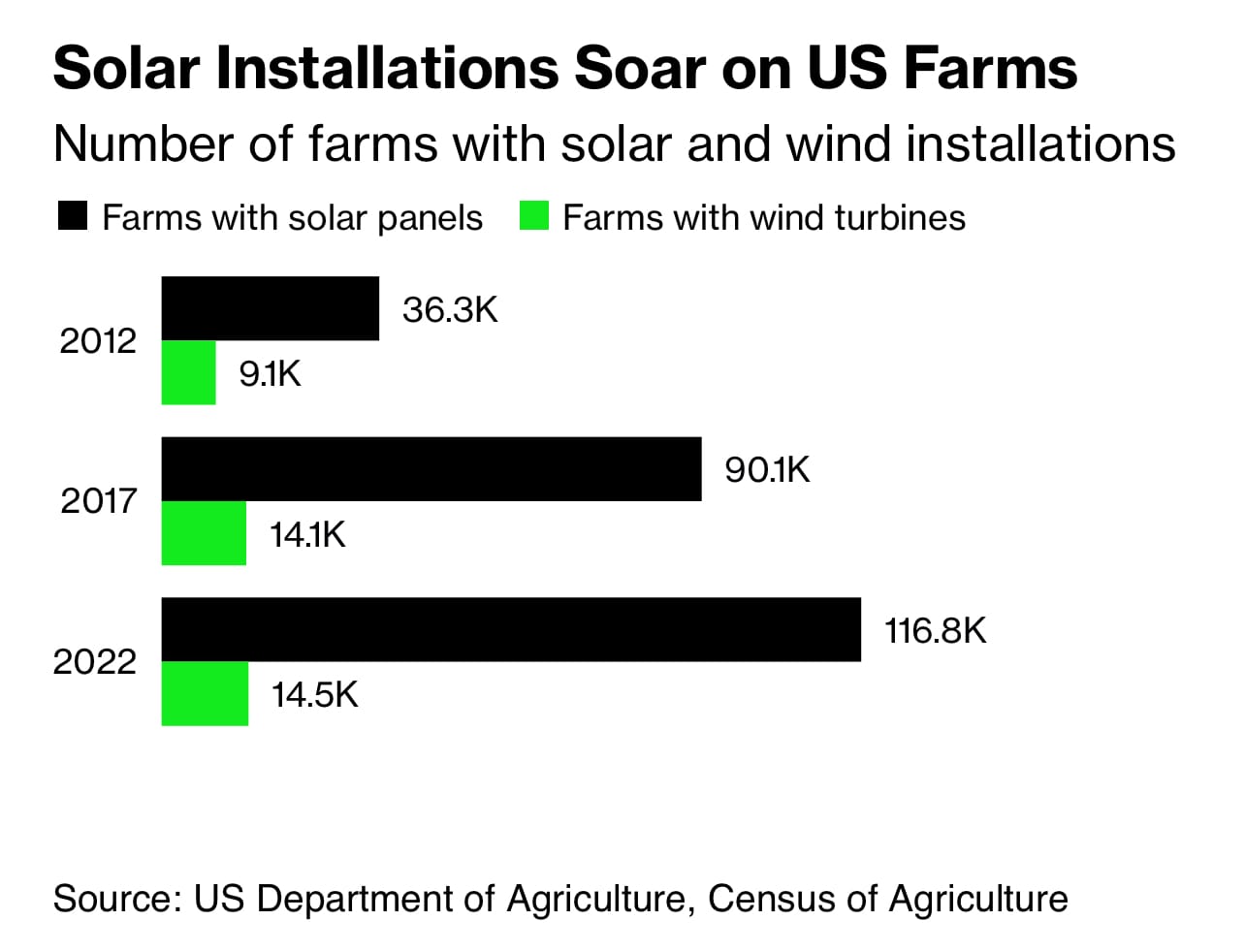
solar as 40% of US electricity would require 5.7 million acres…less than 1% of America’s some 880 million acres of farmland.
estimates $1,200 per acre annually in a solar lease.
lackluster crop markets mean farmers are estimated to lose more than $100 per acre planting corn in Illinois
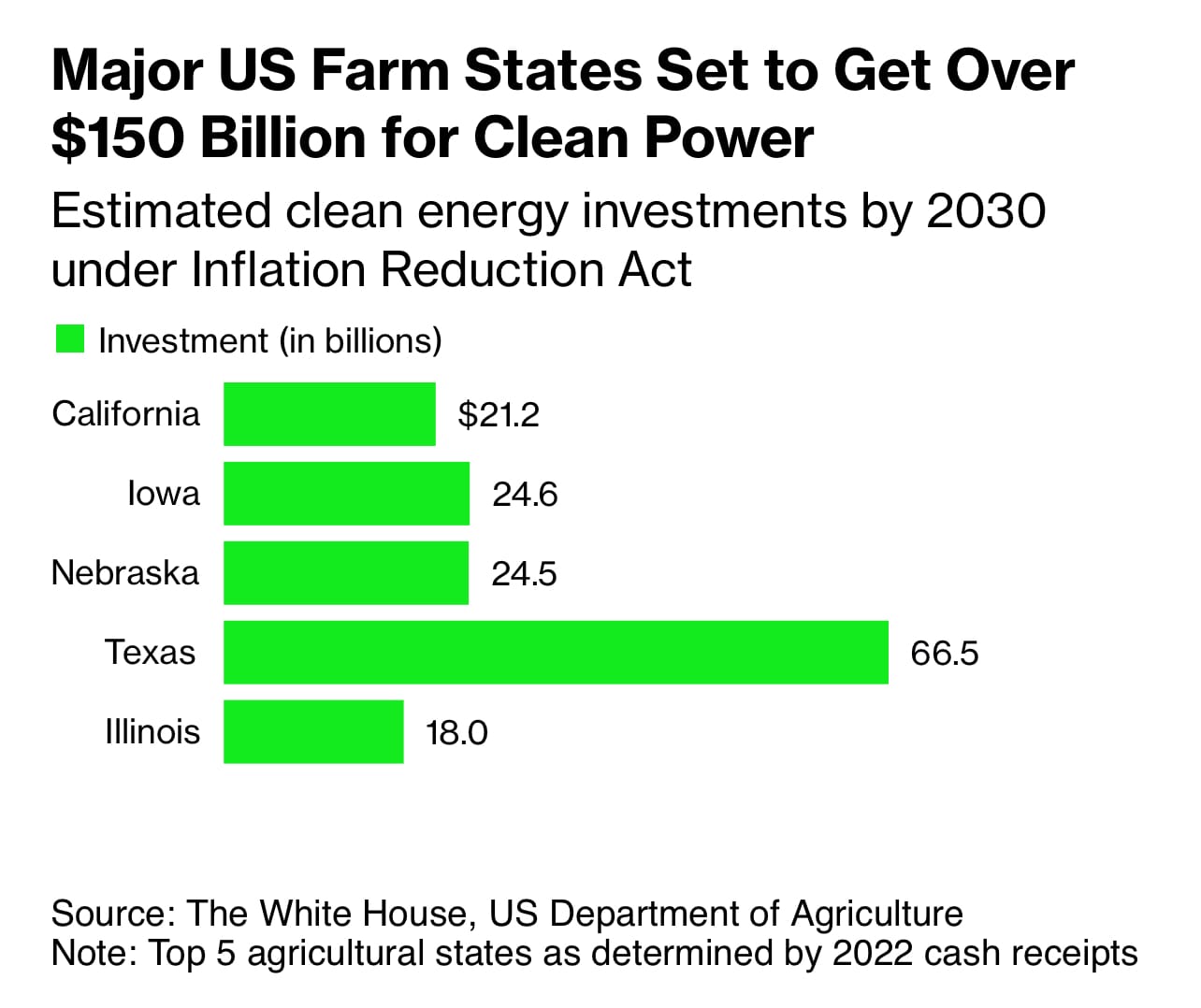
believes solar development should be taking place on the least-productive land, but as farms have to determine what’s best for their businesses it’s leading to a “checkerboard kind of pattern of solar development covering up really great farmland.”
plans to triple the amount of solar on his land — covering about 15% of the total acreage — as panels offer a kind of insurance to the farming business
look at it as almost another crop
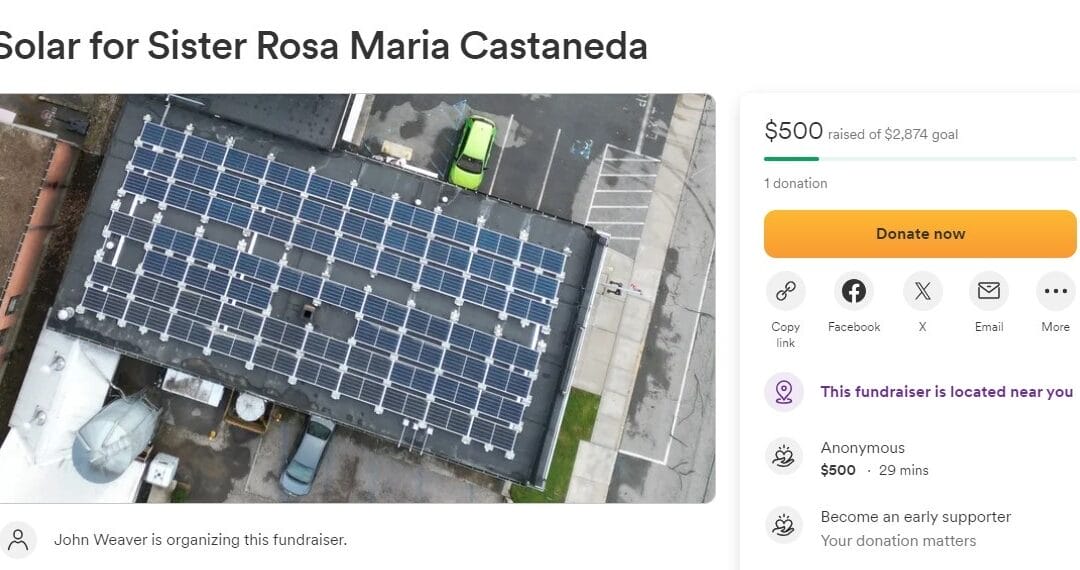
Solar for Sister Rosa Maria Castaneda – please donate
Hello everyone, we’re seeking to raise $2,874 to build a small solar power project on a nunnery in El Salvador. Sister Rosa Maria Castaneda reached out to pv magazine USA seeking guidance on saving electricity costs at their location via solar power. A local installation company gave them a fair quote, and said they’d handle all the paperwork – they just need a check to get moving.
Commercial Solar Guy has donated the first $500 to get the project moving. Please consider donating yourself, or sharing with a wider audience. Thank you!
Solar cell shortage in India for domestic projects
TOPCon cell capacities are underway by some manufacturers, these will be insufficient to cater to the current requirements of domestic module manufacturers
cell manufacturers in India have been prioritizing domestic cell production for in-house module manufacturing or exports, particularly to the US market, exacerbating the scarcity of cells for domestic projects
has resulted in the cost of domestic solar cells being more than two to almost three times that of imported A-grade cells, despite the wafers for cell manufacturing being sourced internationally.
Adding to the complexity, India cells are about 20-35% costlier than imported cells having the same wafers
limits the market for domestic panel manufacturers as government projects under the Ministry of New and Renewable Energy’s schemes and programmes mandate cells to be made in India under the domestic content requirement.
120-125μm solar wafer thickness for most of the market
In 2023, the average thickness of multi-Si wafers will be 170 μm
so it is predicted that the thickness will remain unchanged at 170 μm after 2024, but it is not ruled out that there is still the possibility of thinning in the later period
The average thickness of p-type mono wafers is around 150μm, down 5μm from 2022
average thickness of n-type wafers for TOPCon cells and HJT cells is 125μm, and the thickness of n-type wafers for TOPCon cells is about 120μm, a decrease of 15μm and 5μm respectively compared with 2022

Low polysilicon pricing through June
projected that polysilicon prices will likely remain around the current level until June. However, as production of polysilicon intensifies in the second half of the year, prices are expected to decrease again, potentially falling within the range of CNY50 to CNY55/kg
production cost for polysilicon manufactured outside of China has risen to a range between $15 and over $20. Factors contributing to this increase include global inflation and the growing trend of certain firms purchasing metal silicon from sources outside of China
China Mono Grade, OPIS’ assessment for polysilicon prices in the country were assessed at CNY61.25 ($8.52)/kg
The increase in production costs, primarily manifested by the rise in power prices, has played a role in driving up the price of polysilicon in China
a brand-new, 100,000 MT polysilicon project, whose construction had begun in February last year, was recently found to have been put on hold midway through. In addition, the producer of a 50,000 MT polysilicon project, which commenced production in June of last year, is presently seeking buyers; however, the process was said to have encountered some difficulties
Eastern solar output up 30%, down 10% in the west
In the west, during February mild air from the Pacific banked up clouds and depressed irradiance by 10-20%, according to analysis completed using the Solcast API.
In the east, persistent high pressure in the upper atmosphere led to irradiance as high as 30% above normal, and new records for solar generation and temperature

A clear east/west divide is present in the irradiance anomaly this month. A strong low pressure system sat further east than normal over the Atlantic which brought calm, drier and sunny conditions to the Eastern U.S. and Mexico. Sunnier than normal conditions delivered 20-30% more irradiance than normal from Texas to New England. On the west coast however, high pressure was further west over the Pacific, so that coastal low pressure systems pulled moist air from equatorial regions, leading to increased clouds, blocking irradiance.
Solar project cancelled after 11 years of development
initiative more than a decade in the making to build Nantucket’s largest solar farm on the Wannacomet Water Company property off Milestone Road quietly came to an end this week
Select Board on Wednesday officially voted to back out of the project by terminating a lease agreement with Solar Star Tranquility – a subsidiary of the giant French energy company TotalEnergies – which had been selected in 2019 to develop the 3.8 megawatt, ground-mounted solar array
Permitting challenges – specifically a determination last August by the state that the property was subject to an article of the Massachusetts Constitution that would have required state legislative approval – ultimately led to the project’s downfall

“The size of the project is dead, but we’re looking into doing something smaller scale, within Department of Environmental Protection regulations and what we can do in the well field,”
As recently as last May, TotalEnergies representatives were telling the public that construction would begin in the fall of 2023. But that never happened.
The NLWC’s attorney wrote a legal opinion asserting the water company property was indeed subject to Article 97, while town counsel KP Law authored a conflicting opinion that it was not. In August 2023, the state Executive Office of Energy and Environmental Affairs stated that the property was subject to Article 97.
Oil lobbying against solar since the 1960s
Trade associations in the US and Europe stymied green innovations under the guise of supporting a “technology neutral” approach to avoiding the damage done by burning their fuels.
In 1975, after a global oil crisis, the API opposed an energy saving bill that included refundable income tax credits for heat pumps in homes. “The United States has a large resource base of conventional energy such as oil, gas and coal,” it said. “Expeditious development of these supplies can make a significant contribution not only to improving US energy independence, but to create a healthy economy.”
Offshore wind plus fish farm
At the Marled offshore wind farm, the fish farms are planned to be placed between the wind turbine foundations and anchored with their own anchoring system
fish cages will be lowered to a depth of 50–70 metres and hoisted up to the surface for checks and harvesting.
previous studies show that offshore wind farms can act as artificial reefs and marine protected areas, which increases the amount of fish and shellfish. While larger fishing vessels cannot pass through the wind farm, there are good opportunities for fish farming, the developer says

Fact Sheet: Making the Case for Crops + Solar
Solar energy development is also on the rise, with an estimated 10.3 million acres of land projected to be used for solar energy production by 2050 (Ardani, 2021). This could include up to 1% of U.S. cropland (USDA Rural Development, 2024). Between 2001 and 2016, 99% of the 11 million acres of farmland converted out of agricultural production were attributed to urban and suburban expansion, and 1% was attributed to solar development (USDA Rural Development, 2024).
CROPS Despite the shade of the solar panels, crops still receive the light they need to grow (BarronGafford, 2019). Solar panels that move on tracking systems and follow the sun allow the crops to receive ample sunshine and protection from extreme temperatures and excessive evapotranspiration (Hassanpour, 2018). At the same time, the microclimate created by the crops results in a cooler temperature for the solar panels, which helps them operate more efficiently at lower temperatures.

Farmers in Colorado, Oregon, Arizona, and Massachusetts have seen greater yields and longer growing seasons. They attribute this to the protection of the solar panels, which decreases extremely high temperatures in the summer and increases the cooler temperatures in the fall and spring. The reduction in evapotranspiration from the shading leads to a dramatic decrease in irrigation. In Oregon, they are able grow water-intensive crops like melons, squash, and tomatoes without any irrigation, when the crops are co-located with solar, as shown in Photo 1.
In Arizona, researchers have recorded a 75% decrease in irrigation for tomatoes, beans, basil, and peppers (Barron-Gafford, 2019). The decreased need for irrigation pairs with an increase in soil moisture. In a comparison of agrivoltaic and full-sun crops, the same researchers recorded consistent soil moisture for two days in an agrivoltaic system, compared to two to three hours in a full-sun system (Barron-Gafford, 2023). Measurements of the agrivoltaic microclimate also showed a 2- to 3-degree decrease in temperature. The shade created by solar arrays can also lengthen growing seasons for certain plants. Test farms were able to grow traditional spring crops, like lettuces and chard, well into the summer, and continued producing kale well into the winter (Held, 2022).
24/7 solar plus storage for a mine in Chile
Atlas Renewable Energy, an international renewable energy leader, has signed a power purchase agreement (PPA) with Codelco, the state-owned Chilean mining company and the world’s largest copper producer, for the supply of 375 GWh of 24/7 energy per year
Projects says it will get 24/7 electricity from renewable sources – says batteries involved. Nothing else noted.
Missouri bill to limit solar to 2% of cropland
House Bill 2651 would restrict the amount of real estate used for solar power in any Missouri county from exceeding 2 percent of all cropland in that county
“My district is greatly affected by this issue, and it’s been a very divisive issue,” said Rep. Kent Haden, R-Mexico, the bill’s sponsor. “I have landowners who want to lease their land to solar facilities, and I think they have that right to do that. It’s their land, they can do what they want to do with it. I also have people that are adjacent to it who have quarter- to half-million-dollar homes on 10 acres that will be surrounded on four sides by solar, and that changes the value of their property.”
Haden’s bill also would require 75 percent of solar panels and equipment used in Missouri solar projects to be of U.S. origin, he said, adding that 80 percent of solar panels are currently made in China.
Statewide, the share of land used for agriculture is shrinking, with 15,599,446 acres of total cropland in 2017 compared to 14,764,750 acres in 2022
55,000 pound capacity 100 kWh electric forklift
first commercially available, large-capacity, electric forklift made in the US into service
55,000-pound capacity Wiggins Yard eBull battery electric forklift
capable of lifting up to 25 metric tons, making it one of the largest electric forklifts in the US.
over 100 kWh of onboard energy storage, and it can support eight-hour shifts with Level 2 charging or double shifts with DC fast charging
electric forklift investment was supported by California’s Clean Off-Road Equipment (CORE) voucher program

Utility upsizes battery 4X – why?
I wonder if they’re upsizing because of the drop in the price of batteries.
project’s storage capacity would increase from 400 MWh to 1,600 MWh
400 MW solar PV facility integrated with a battery storage system
project involves capital investment of more than one billion dollars and will commence construction in the second quarter of 2024
developer last month announced it secured up to $460 million in investments from Sandbrook Capital
IRS detect pay & transferability guidance released
elective pay (otherwise known as “direct pay”) and transferability
allows tax-exempt and governmental entities to receive elective payments for 12 clean energy tax credits, including the ITC and PTC (Sec. 45 and 48 credits), as well as tax credits for electric vehicles and charging stations
allows businesses to transfer all or a portion of any of 11 clean energy credits to a third-party in exchange for tax-free immediate funds, so that businesses can take advantage of tax incentives if they do not have sufficient tax liability to fully utilize the credits themselves
final rules also lay out the process and timeline to claim and receive an elective payment
entities treated as partnerships for federal tax purposes are not eligible for elective pay
IRS agreed with commenters that existing guidance on making a valid election out of partnership tax treatment for clean energy arrangements was limited, and updates were needed for these arrangements to be more effective
3 GW/7.7 GWh energy storage connected in China during Jan/Feb
January and February 2024, a total of 99 new energy storage projects were commissioned
capacity of nearly 3 GW/7.743 GWh
January 186.8% increase compared to January 2023
February 2024 fell back to normal levels, a 12.5% year-on-year increase
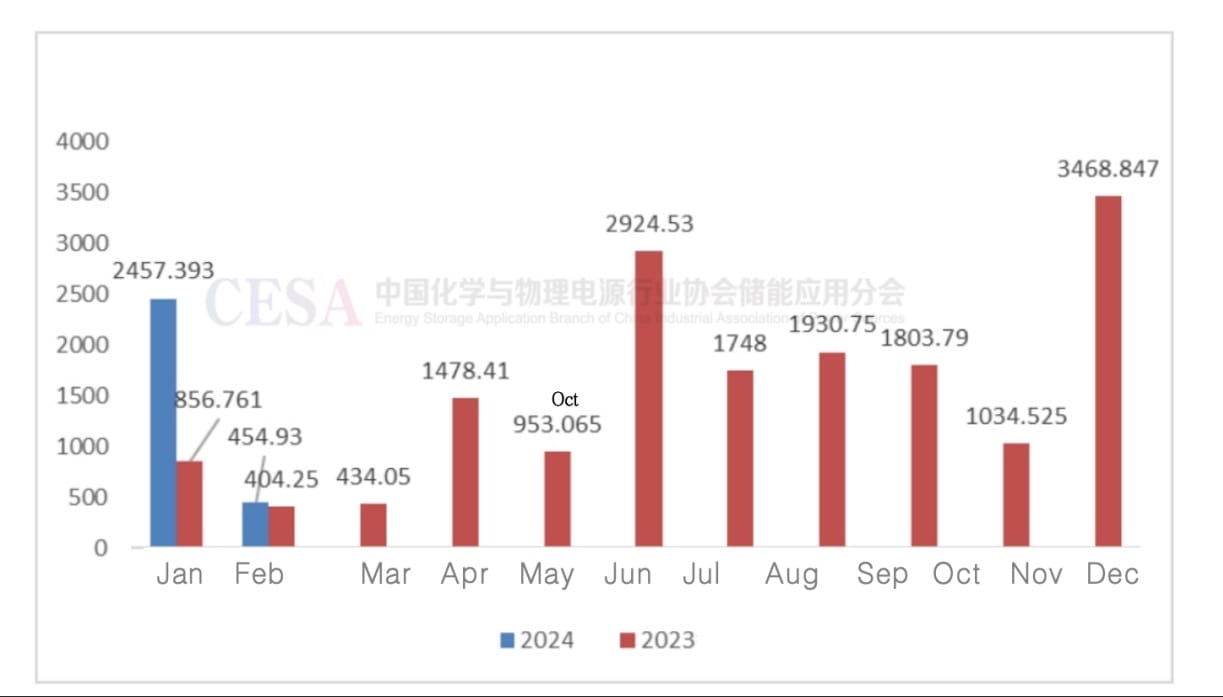
Grid-side energy storage projects totaled 1.613 GW/3.426 GWh, accounting for 55%
All source-side energy storage projects were new energy source-side storage projects, totaling 1.003 GW/3.316 GWh, accounting for 35%
37 GW of solar for US in 2024, WoodMac
Wood Mackenzie Renewables & Power says ‘solar sector added 32.4 GW in 2023, 51% higher from 2022’
an additional five gigawatts (GW) over last year’s capacity could be installed in 2024
Growth-rate expectations for the commercial, community and utility-scale segments are 19%, 15% and 26% for the year
high case for U.S. solar with increased supply chain stability, more tax credit financing and lower interest rates would increase our (solar installation) outlook (by) 17%
low case with supply chain constraints, less tax credit financing and static interest rates would decrease our outlook (by) 24%
California’s residential solar installation is expected to decline by 13% in 2024 on the shift to NEM 3.0
Community Solar is PURPA federal program says California judge
found that the Net Value Billing Tariff (NVBT) policy these groups support “conflicts with federal law and does not meet the requirements” of AB 2316, the 2022 state law that ordered the CPUC to create an affordable and equitable community-solar program
California utilities argued that, unlike rooftop solar, batteries, electric-vehicle chargers and other distributed energy resources connected to the low-voltage distribution grid, which are subject to state jurisdiction, the community-solar and battery projects envisioned for NVBT fall under federal law that governs larger-scale generators operating in wholesale energy markets
nonprofit advocacy group for California utility customers stated that there is “no instance of FERC asserting jurisdiction over, or ordering changes to, a virtual net metering tariff or community renewable energy program approved pursuant to state law.”
Hymes appears to dismiss these points in Monday’s proposed decision, stating that “the NVBT proposals do not equate to retail rate programs but instead resemble wholesale electricity procurement.”
trade group representing solar developers which created the NVBT in 2021, excoriated the proposed decision in a Monday press release, stating that it “manages to both misinterpret federal law and our proposal, and ignores precedent that has been set by states deploying community solar for more than a decade.”
CPUC’s proposed decision also conflicts with the view of 20 California lawmakers involved in passing AB 2316, who in a September letter to the CPUC told the agency that the NVBT “most closely aligns with the intentions” of the law
proposed decision would order the state’s utilities to meet AB 2316’s mandate not via the NVBT, but by altering existing community-solar and wholesale-market distributed energy programs
California has less than 600 megawatts of large-scale distributed solar developed to date, compared to a total of 6.2 gigawatts in the 22 states with policies that support community-solar programs
CPUC Administrative Law Judge Kelly A. Hymes — who also crafted the CPUC’s rooftop-solar decision and another decision slashing compensation for shared solar systems for multifamily properties, schools and farms in most of the state — will cut off what may be the last viable avenue for non-utility-scale solar in a state that’s still far off pace to meet its clean-energy goals
Quasi-ohmic layer extending perovskite life
I don’t know a bunch of these words, but aggregated I get it – perovskites lasting longer
introduce a generic approach featuring a Lewis-acid layer sandwiched between dopant-free semicrystalline polymer and metal electrode in perovskite solar cells, resulting in an ideal quasi-ohmic contact even at elevated temperature up to 85 °C
integrating the polymer-acid-metal structure into solar cells, devices exhibit remarkable resilience, retaining 96% ± 3%, 96% ± 2% and 75% ± 7% of their initial efficiencies after continuous operation in nitrogen at 35 °C for 2212 h, 55 °C for 1650 h and 85 °C for 937 h
Leveraging the Arrhenius relation, we project an impressive T80 lifetime of 26,126 h at 30 °C.
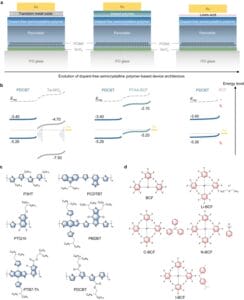
Truckyard EVs outlasting diesels
Diesel yard trucks which are often used just 5 years or 15,000 hours before maintenance and repair costs become prohibitively expensive
We do oil changes every 5-10,000 miles and try to maintain a 400-500,000 hour overhaul on the heavy equipment trucks – barring clutch replacements
Orange EV currently has 35 trucks exceeding 15,000 hours of operation – 14 of which have surpassed 20,000 hours – with many more that will cross those thresholds soon
dubbed “Sparky I” and “Sparky II,” the electric semi trucks have individually clocked more than 24,000 hours and 17,000 hours of operation. What’s more: they’re still on their original battery packs.

10 GW of solar panels tendered in China at $0.12/W
Huaneng Group concluded a PV module procurement process on March 4
selected eight manufacturers – JA Solar, JinkoSolar, Huayao PV, Longi, Tongwei, GCL SI, Risen, and Huasun
tender section for 2 GW of P-type panel products resulted in an average price of CNY 0.842 ($0.12)/W
7.5 GW of tunnel oxide passivated contact (TOPCon) and 500 MW of heterojunction solar cells (HJT) – totaling 8 GW of N-type products – the average price was CNY 0.887/W
companies will collectively share 10 GW of orders, but the specific allocation among them has not been disclosed
New solar farm increases plant biodiversity
50MW Oakley Solar Farm – set to boost biodiversity net gain by 62%
developer design a planning application which incorporates over 2,800 new trees, 605 metres of new hedgerows, 61 acres of new wildflower meadow and 166 acres of “species-rich” grassland alongside four new wildlife ponds
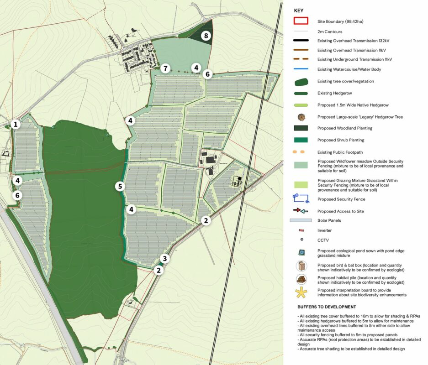
1.7 GW of Italian batteries valued at $2.5 billion
Utility and IPP Enel has sold a 49% stake in its subsidiary that will own and operate 1.7GW of battery energy storage system (BESS) projects in Italy, to investor Sosteneo
The deal, which will see Sosteneo’s ‘Sosteneo Fund 1 HoldCo S.à.r.l’ pay €1.1 billion (US$1.19 billion) for the stake
23 battery energy storage system (BESS) projects as well as three renovations of open cycle gas turbine (OCGT) plants totalling 0.9GW
Italy incentivizing 35% of EU manufactured solar panels
new fiscal credits to purchase components for renewable energy projects
fiscal credits for PV could reach up to 35% of the cost of the solar modules
awarded to projects that exclusively use solar panels made in the European Union
panels with module efficiency ratings of more than 21.5%, or products with cell efficiencies above 23.5%
awarded to projects that use either heterojunction or perovskite-silicon tandem modules with efficiencies of more than 24%
tax credits will be recognized for up to 35% of a total investment of up to €2.5 million ($2.71 million) and up to 5% for total investments of €10 million
maximum limit of eligible costs is equal to €50 million per year per beneficiary company
designed for plants intended for self-consumption, but in principle we can’t exclude that an excess quota possibly released into the grid could be compatible with the public incentives
Colorado co-op 90% renewables by end of year – pays to not use kWhs
co-op will be 90% renewable generation by end of this year
The growing storage capacity “basically behaves like gas turbines would on a normal power grid,” Hannegan said, with the ability to in effect turn them on at will to send instant power to members.
Buying portions of projects spread geographically across the state is intentional for the renewables transition, Hannegan said. “It’s less likely that all of those resources are going to be out of commission all at once,” he said.
While Holy Cross announced a rate increase in February, it says residential rates are still lower than any other Colorado co-op, and that far lower prices for renewable generation projects have helped keep costs low.
Holy Cross already takes that concept a step further, not by raising peak prices but by “paying” customers for cutting back on their normal peak use, Hannegan said. That payback rate will increase in April to $1.50 per kilowatt hour of savings.
Holy Cross also supports rooftop solar, home battery storage, EV hookups, and community solar projects.

Holy Cross fulfilling its members’ mandate to expand renewables advanced quickly in 2023, through the following projects:
- Bronco Plains 2 wind farm near Flagler contributes 150MW of its 200MW capacity to Holy Cross in winter months, supplying 30% of Holy Cross customer needs. The project was built by the for-profit energy company NextEra Energy Resources.
- Hunter Solar near Bennett in Arapahoe County will divide up 75MW of panel power, with Holy Cross taking 30MW, or enough for a few thousand households. The rest of the power goes to the CORE Electric Cooperative, serving 176,000 members in rural areas surrounding metro Denver.
- High Mesa Solar and Storage at Parachute brings 10MW of panels and 20MW of storage, an all-important growth area for utilities switching to renewables. The battery array can dispatch power at night, during peak demand or on days when sun and wind aren’t producing adequate supplies.
- Mamm Creek Solar and Storage brings the same 10MW of panels and 20MW of storage to the Rifle area.

Module manufacturer asking for Chinese project bidding reform
LONGi has called on the Chinese government to introduce new bidding rules to crack down on low prices and ensure the sustainable development of the renewables industry in China
prices were often the sole criteria in the bidding process for solar PV components
After winning the bid, these manufacturers lowered the costs of procuring materials and production to compensate for the losses, resulting in lowered product quality
solar manufacturers will negotiate with buyers as it is very difficult for the buyers to admit that a wrong decision was made in the last tender
solar manufacturing industry in China should introduce a new bidding method. For example, buyers can use the average prices of the bids as criteria and eliminate the highest and lowest prices, which could encourage solar manufacturers not to submit bids with unreasonably low prices
introduce regulations to ban submitting bids with prices lower than costs, while designated authoritative industry associations should also issue guidelines on a regular basis
BNEFin 2024: 520 to 655 GW solar to deploy, 1.1 TW of poly available – some US factories announced will be cancelled
photovoltaic industry added about 444 gigawatts of new capacity in 2023, a 76% growth on 2022 build
We only see about 574GW(DC) of module build in 2024, mainly limited by local factors such as access to grid, land and labor

China alone added 216.9GW(AC) or 268GW(DC) in 2023, 60% of the world market, and we do not expect it to fall
Enough polysilicon could be produced by major suppliers to make 1.1 terawatts of modules this year
We have tightened the criteria for tier 1 manufacturers and hence the tier 1 lists have been shortened, but there is still enough module assembly capacity belonging to the tier 1 players to make 783GW of modules per year
BNEF suggests from 520 to 655 GW possible solar installations, with 574 GW about the middle value.
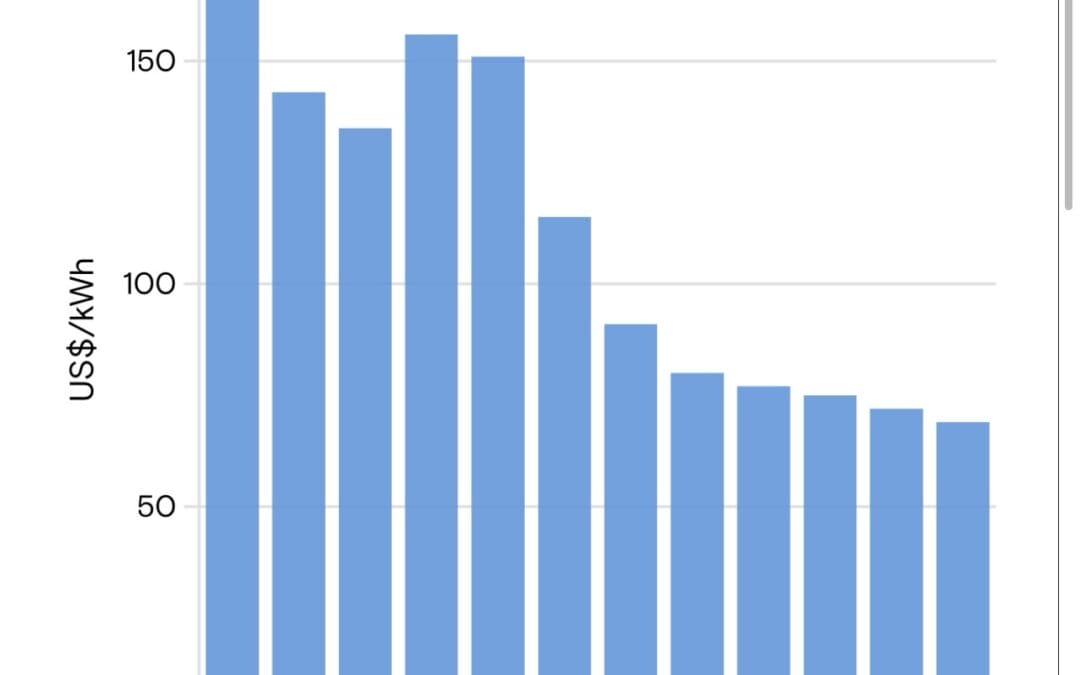
Battery prices down 40% 2023-25, Goldman Sachs
lowered its forecast for growth in global battery demand in 2024 to 29% year-over-year, compared to its previous projection of 35%. Battery demand is estimated to have increased 31% in 2023.
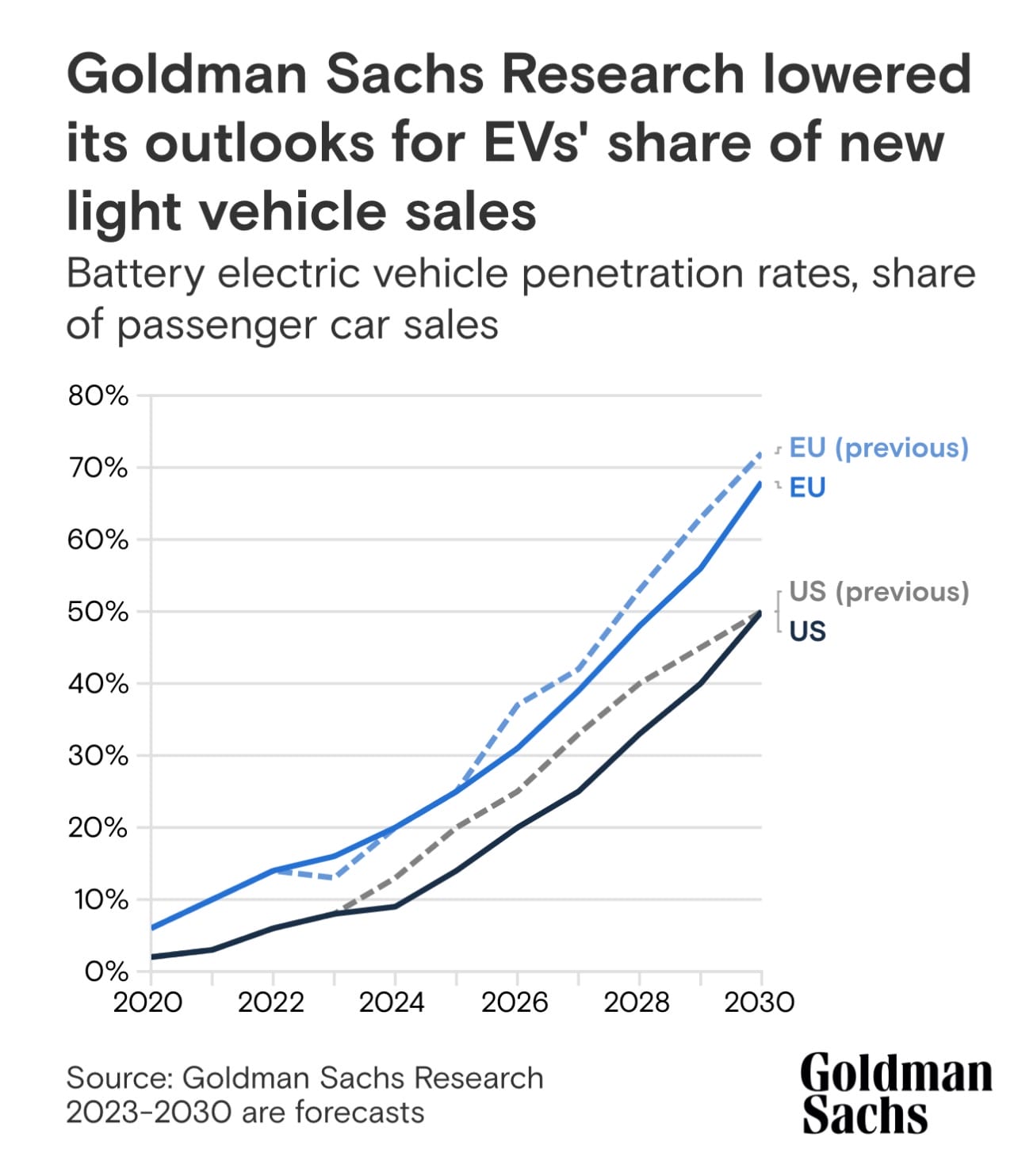
Longer term, our analysts project EVs to take a considerably higher share of car sales, reaching 50% in the US and 68% in the EU by 2030.
Goldman Sachs Research expects a nearly 40% decline in battery prices between 2023 and 2025, and for EVs to reach breakthrough levels in terms of cost parity (without subsidies) with internal combustion engine cars in some markets next year.
Major innovations like solid-state batteries (as opposed to using liquid electrolyte as in batteries today) could, in the coming years, be a game-changer for the industry, as solid-state batteries are expected to allow carmakers to pack in even more energy, for the same amount of weight, than a conventional battery.
Solar slowed CO2 emissions in 2023, global droughts pushed back up
IEA’s CO2 report shows that global carbon emissions rose 1.1% in 2023, reaching a historic high
comparative rise in emissions is lower than in 2022 (1.3%)
Without the expansion of renewable deployments, this figure would have been significantly higher
large caveat: global droughts – in China, the US and several other regions – caused a steep drop-off in hydropower generation over 2023
Over 40% of the rise in emissions was accounted for by the absence of expected hydropower capacity
Had these droughts not occurred, the IEA said that global emissions from electricity generation would have fallen, which would in turn have significantly lessened the increase in total emissions
world deployed 420GW of solar PV capacity in 2023, a vast 85% increase from the 228GW installed in 2022
261GW of this new capacity was deployed in China, followed by the European Union (53GW), the US (32GW) and India (12GW)
Fossil government demand’s agrivoltaics, creates “view scapes”, and visual tests to limit renewables
government of Alberta has implemented a new “agriculture-first” approach to approving solar and other renewable energy projects on land in the Canadian province
new laws follow a seven-month pause on all new renewable power project approvals, assessment of the viability of 26 solar generation projects was suspended
Alberta will no longer permit renewable generation development on class one and class two lands unless the proponent can demonstrate the ability for both crops, and/or livestock, to co-exist with the renewable generation project
protected areas and what Smith called “pristine viewscapes” will now be surrounded by a 35km area in which new wind projects will not be allowed to be constructed due to concerns that they will impact views of the local area
renewable power facilities, such as solar and storage, will also be subjected to what Smith called a “visual impact assessment” as part of the permitting process
Politics and war drove Europe’s solar boom, not cheap modules
It is interesting to note that the market in Europe hasn’t waited for lower prices to develop while prices started to go down significantly in 2023 and especially after summer (see above), the lead time to develop utility-scale PV plants is in general about more than one year.
As it has been mentioned numerous times, even the COVID pandemic wasn’t able to halt the PV market in Europe and globally.
The wake-up call for several countries was the deadline of the 2020 renewable energy targets and the acceleration of 2019 can mostly be attributed to the political change seen in several key countries from 2017 onwards: France or Spain, for instance, saw a set of ambitious energy policies that allowed PV to develop faster.
Consequence of new policies in key countries following the energy stress caused by the war in Ukraine. While PV market development was already growing in Europe, it accelerated significantly after February 2022.
The new German coalition paved the way for the current acceleration of the market, while prices were skyrocketing in 2021 and 2022.
Hence, the major price increase seen in 2021 and 2022 for PV modules, mostly coming from disrupted value chains in China and increased transport costs, didn’t halt or reduce the PV market in Europe; it continued growing significantly.
Solar electricity pricing down 99.9983% over 67 years
From a post on LinkedIn by Bloomberg New Energy Finance’s Nat Bullard:
Instructive example from Greg Nemet‘s excellent book “How Solar Energy Became Cheap” (2019):
“A megawatt-hour of PV electricity in 1957, for its first commercial use, cost about $300,000 in today’s dollars…Today in a sunny location, that megawatt hour costs only $20. Thus, the cost of that electricity has fallen by four orders of magnitude, a factor of 15,000 cost reduction.”
We’ve had inflation since then, so $300,000 in December 2019 dollars is about $360,000 today. Also, 2019 power purchase agreements at $20 per megawatt-hour were edge cases and potentially untenable; today’s PPAs are likely closer to $60/MWh than $20/MWh.
The result, then, is still fairly striking: a 99.9983% decrease in cost over 67 years.
3.2 mm tempered solar glass protects against hail
During the Hail Stress Sequence, sample modules are struck by a 50mm lab-manufactured ice ball at terminal velocity (32 meters per second) in 11 different locations at a zero-degree angle. PVEL adds that the simulated hail strikes deliver an impact energy of 31.4 joules, comparable to the approximate impact energy of a 77mm strike with the same density at terminal velocity at 30 degrees.
Generally speaking, laboratory-made hail is extremely dense and more uniform than natural hail, so its impact energy is usually far greater; the impact energy of a lab-made 50mm ice ball is comparable to a natural hailstone as large as 100mm in diameter, depending on their density and impact angle.
PVEL has identified three consistent patterns of hail damage:
First, in strings with two or more broken glass modules, the cells of the remaining modules with intact glass are likely to experience severe cracking.
Second, in sites with a capacity of more than 100MW that suffer glass breakage from hail, it is likely that some areas of the array will not have any cell damage.
Third, glass breakage and cell cracking will be variable in the areas of the site between the two above extremes.
Glass breakage rate of glass-glass modules could reach 89% if they are impacted by hail of 50mm diameter
Breakage rate drops to only 34% for glass-backsheet modules that use fully tempered glass
“As true heat-tempered glass is generally twice as strong as glass that is ‘heat-strengthened’ only, our test data shows that PV modules made with 3.2mm fully tempered front glass are approximately twice as resilient to impact as modules packaged with 2.0 mm heat-strengthened front glass.”
To determine if it was financially viable to stow, stow, stow your solar modules during a hail event:
Under a US$22 per MWh power purchase agreement (PPA), moving into the hail-stow mode during WWA events throughout the year for this particular simulated site resulted in a total production loss of US$12,000, or 0.1% of the US$9.75 million estimated annual revenue.
Cancer diagnosis ends small Australian solar company
G-Store, founded in 2007, was placed into administration on 2 February 2024 with Newscorp outlets reporting that the company’s sole director had been diagnosed with cancer.
Melbourne-headquartered solar company G-Store Pty Ltd has collapsed.
The administrator said the company owes 139 unsecured creditors $2.2 million, while secured lenders are owed the remainder of the $3.8 million debt.
“Get a heat pump, the grid’s going to collapse!”
I talked to my electrician, who I’ve used for many years. But he’s clearly influenced by the conservative media’s take on all this climate stuff. He was pooh-poohing heat pumps: “Natural gas is great. If you get a heat pump, the grid’s going to collapse!”
Going from a gas furnace to a ducted heat pump was a little painful because we had to redo some of our ducts. Heat pumps need a higher volume of air circulation to work because the temperature differential isn’t as strong.
But by far the most painful piece of the retrofit was the blown-in insulation. We had to Swiss-cheese our walls and move every single piece of furniture in our whole house because the contractor needed 4 feet of working space around all the walls.
We had a nuisance outage — the power went out for a couple of hours. I was traveling that week, so he texted me: “Hey, I just got this ping, and our block is blacked out. I didn’t even notice! We still have power here. This is great.”

“No” solar panel import ban, EU energy chief
EU energy policy chief Kadri Simson
Simson ruled out cutting off imports, which she said could compromise the EU’s ability to install enough solar energy capacity to meet climate targets
“There are different proposals how we can support our industry, but clearly we cannot close our borders because we need solar panels”
Fiberglass solar panel frame
fiberglass frame, which the manufacturer said is more resistant to corrosion than conventional frames
Leapton is offering three versions of the panels, with power outputs ranging from 560 W to 585 W. The efficiency ratings range from 21.68% to 22.65%. The open-circuit voltage is between 47.42 V and 48.42 and the short-circuit current is between 15.00 A and 15.27 A. The maximum system voltage is 1,500 V.
The panels measure 2,278 mm x 1,134 mm x 30 mm and weigh 28 kg
Bifacial tariff exemption being fought – 2-3¢/Wdc added cost
Solar manufacturers – First Solar specifically are pushing to get rid of the import tariffs on bifacial solar modules.
“Yeah I think it would be a 14.50% tariff which would mean ~+$0.03/W. [We have] 100% of our panels sourced from domestic suppliers, so we have zero exposure. I think I calculated the total 201 tariffs that would be paid over by US importers would be ~>$1bn in the final two years of the 201 case. I haven’t talked to a single importer that doesn’t pass this ‘change of law’ risk on to their buyer.”
“it would be awkward to restore coverage of bifacials while we are inside a two-year emergency period.” As a result, he would “be highly surprised if [the 201 bifacial removal] happens before end of May,” and the probability for the 201 bifacial exemption to be removed is high—perhaps ~80%.”
“Essentially it would increase price by 2-3c across the board for import and roughly 1 cent for US assembly (assuming imported cell).”
Green hydrogen dumped for interconnection at world’s largest wind farm
UK offshore wind project Dogger Bank D is abandoning its original plan to produce green hydrogen
Britain’s SSE and Norway’s Equinor and Vårgrønn had been exploring the prospect of using the power from the 2 gigawatt (GW) fourth phase extension of the giant North Sea wind for what would have been the UK’s largest green hydrogen production facility
with the confirmation of an onshore grid connection, the green hydrogen project had been scrapped
Dogger Bank D will now connect into Birkhill Wood, a proposed new 400kV substation located in the East Riding of Yorkshire which will be built as part of the UK’s ‘Great Grid Upgrade’
5.6 GW wind farm will be the largest in the world, and is being built in four phases: three 1.2 GW phases with Dogger Bank A, B and C, and one 2 GW phase in Dogger Bank D, with a mixture of Haliade-X 13 MW and 14 MW turbines
Massive solar+wind+storage facility by Australia’s largest coal company
Energy utility AGL, Australia’s biggest coal generator and polluter
still operates the Loy Yang A brown coal generator in Victoria and the Bayswater plant in NSW
unveiled – Pottinger Energy Park – to be developed with the privately held Someva Renewables, will include a 1.2 GW wind farm (with more than 200 turbines), a 300 MW solar farm, and a 500 MW, 2000 MWh battery
project will be a key part of the 12GW of new wind, solar and storage that it plans to build over the next decade
could start construction in 2026, creating up to 800 construction jobs and 60 ongoing jobs
China needs 4 TW of solar, 1 TW storage by 2060
will need nearly 6 terawatts of solar and wind power to achieve its goal of becoming carbon neutral by 2060
would be double China’s total energy generation capacity now, and more than five times the current capacity in the United States
will need to have 2TW of wind power capacity and 3.9TW of solar installed
required deployment rates in mid-century are close to what has been reported for 2023, though there will still be challenges to sustain that over time
1,000 gigawatts of energy storage will also be needed to provide reserve energy during peak demand, mostly for solar
model was created with the expectation that China would continue to “exploit” its existing hydropower resources, and that just over 200GW of coastal nuclear power would be added.
Large sheep farmer adding solar agrivoltaics
4,738 acres of private land run by the Tillard ranching family near Glenrock
1 million solar panels
499 MW of solar generation with onsite battery storage. 300 MW will be allocated for Stage 1 and 199 MW for Stage 2.
expected to generate more than $200 million in state and local taxes over the life of the project
2-5 permanent O&M jobs
in the county – For roughly every 20 residents, there is one wind turbine, the highest ratio in the state. At a recent County Commissioners meeting, it took another step in diversifying its energy infrastructure, signaling its intent to issue its first solar farm permit to BrightNight.
Willox has been a Converse County Commissioner for the last 18 years, during which he’s witnessed the rise, fall and rise again of fossil fuels in the county. When he first started his job, coal production was a huge economic asset to the county. Now, “it’s zero,” he said.
In the early spring grazing time, which is when the most intense grazing is and the most growth is, we could put more sheep on the agrivoltaic array than on the open pasture, and the sheep grew at the same rates,” said Higgins, an associate professor in Oregon State University’s department of biological and ecological engineering. “There was overall more production in that intense grazing period because of the solar panels.”
“We actually had to fence the sheep in the open field to keep them in the open field, because, given the choice, they all preferred to be in the solar.”
Solar electrical balance of system provider growing
Shoals will invest $80 million over the next five years to expand its existing manufacturing and distribution operations to a new, larger location in Portland, Tennessee
expansion will create approximately 550 new jobs over the next five years in Sumner County, bringing the company’s total headcount in the region to roughly 1,400
deployed on over 62 GW of solar systems globally
Solar cell & module factory gets construction permit
solar cell/module manufacturing facility is one step closer to opening in Fort Mill after securing its construction permit
proposed Silfab Solar manufacturing facility off Highway 77 to begin construction
800 jobs to the region, starting at an hourly wage of $19 and $60,000 for salaried employees
synthetic minor permit, released Friday, details the emissions requirements for the factory as well as regulations regarding how the company must handle chemicals the EPA identifies as hazardous air pollutants, such as hydrochloric acid, hydrofluoric acid, toluene, and silane. The chemicals will be stored on-site and used in the manufacturing process
opposition from Fort Mill and York County neighbors. Concerns range from the traffic impact of the facility to its water usage but primarily, many are concerned about how close the facility will be to two York County schools, currently under construction on properties directly adjacent to the Logistics Lane facility
Deep sea solar in Italy
offshore hybrid project featuring 120 MWp of PV and 420 MW of wind
28 floating wind turbines
Dutch-Norwegian offshore PV specialist SolarDuck, Italian investment fund Arrow Capital, and Italian developer New Developments have signed an agreement to develop
will feature SolarDuck’s elevated platform technology, which allows PV panels to be deployed in significant wave heights, while maintaining a safe working environment for access and maintenance and minimizing environmental impacts
hold the solar panels more than 3 meters above the surface of the water, and are able to handle coastal sea conditions and hurricane-force winds
basic floating platforms are triangular structures measuring 16 meters x 16 meters x 16 meters
SMA up 78% in 2023
20.5GW of inverters were sold in 2023, increasing from 12.2GW in 2022
sales increased to €1,904.1 million (US$2057.1 million), up from €1,065.9 million in 2022 – increasing by 78.6% year-on-year
EBITDA increased significantly to €311 million in 2023 from €70 million in 2022.
sales of all three segments improved
home solutions segment increased its sales to €580.2 million, up from €335 million in 2022.
commercial and industrial solutions segment, sales rose to €478.9 million from €290.3 million in 2022.
The large scale and project solutions segment increased its sales to €845 million, up from €440.6 million.
As of the end of 2023, SMA Group’s order backlog dropped to €1,705 million, down from €2,077.4 million in 2022. Of the total order backlog, €1,329.8 million was attributable to product business
Battery saves grid upgrades
battery system also allowed BGE to avoid the costs of upgrading some 10 miles of electric distribution infrastructure – probably $1-3 million
Fairhaven experiences a winter peak due to the usage of electric heaters. Because of this, the area’s total electricity load sometimes topped the capacity of the 34.5kV line in the region.
storage system helps address that issue by absorbing energy during times of low electricity demand and then discharging it back to the grid when demand increases
a 2.5 MW/9.74 MWh battery energy storage system
two battery containers with 48 racks of lithium-ion batteries, the company said, as well as a control system and two new distribution transformers
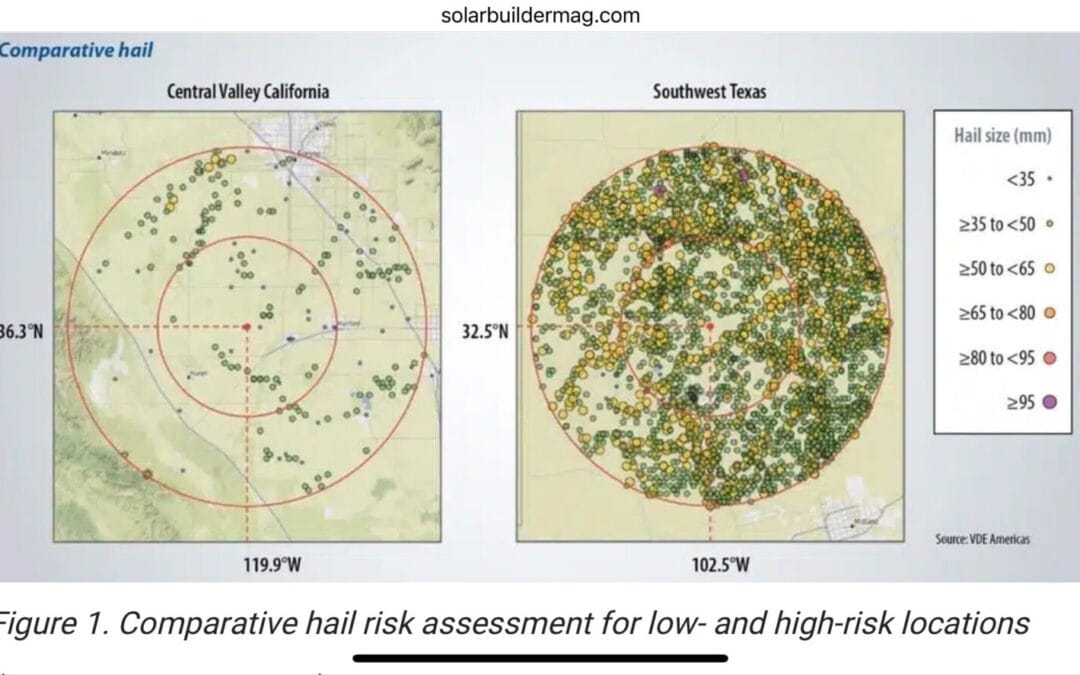
Stow, stow, stow against hail
Hail damage mitigation – most rules revolve around: stowing the solar panels often, quickly, and by default.
- The radius for weather service alerts should be no less than 30 miles away from the project perimeter.
- Deploy one hail sensor or system for each square kilometer with spatial coverage across the full project footprint.

Also, did you know there’s such a thing as a hail pad to corroborate hail size speculation?
35 MW rooftop solar plant – world’s largest?
SolarFuture ApS from Albertslund has landed the order to establish a 35 MW rooftop solar power plant at DSV’s new logistics center in Horsens
building at DSV’s logistics center is over 300,000 m2, an area that corresponds to the world’s 5th largest building
Project Data — DSV Logistikcenter, Horsens:
- Total output of the solar system: 35 MWp
- Annual production: 33.15 GWh
- CO2 savings: 5,300 tonnes of CO2 per year
- Mounting system: Ballast system
- Location: East/West for optimal even production around the clock
Solar powered hydrogen by Chevron in California
Chevron U.S.A. Inc., is advancing a 5MW solar-powered hydrogen production project in California’s Central Valley
initiative harnesses solar power, land, and non-potable produced water from Chevron’s assets at the Lost Hills Oil Field in Kern County to create lower carbon energy
Electrolytic hydrogen, produced through electrolysis, will have low carbon intensity
targeting a production capacity of two tons of LCI hydrogen daily
Australia seeking AU$67 billion of new wind, solar & storage
Australia currently has about 33 GW of solar, and 9 GW of wind generation capacity installed.
Australian federal government is to seek 10 gigawatts of new wind and solar capacity this year, along with 3 GW of dispatchable (storage with 4 hours) capacity
comprising a 6 GW tender for wind and solar in the next quarter, and another 4 GW in the second half of the year
federal and state governments agreed last year to expand the CIS to 32 GW, which would include 23 GW of new generation and an expanded target of 9 GW of dispatchable capacity, broadly described as four hours of storage.
plan for the CIS program is to hold tenders every six months, and basically lock in projects by 2027 so they can be built by 2030
Christiaan Zuur, from the Clean Energy Council, estimates that the 23 GW of renewable capacity sought through the CIS will equate to $52 billion of investment, and the 9 GW of dispatchable capacity will represent another $15 billion.
India seeking 10 million residential solar rooftops
central financial assistance (CFA) of 60% of the system cost for 2 kW systems and 40% of the additional system cost for systems between 2 to 3 kW capacity
capped at 3 kW
INR 75,021 crore (over $9 billion) for installing rooftop solar and providing free electricity up to 300 units (kWh) every month for one crore (ten million) households
Households will be able to access collateral-free low-interest loan products of around 7% at present for installation of residential RTS systems up to 3 kW
proposed scheme will result in addition of 30 GW of solar capacity through rooftop solar in the residential sector
Recycled solar glass pure enough to be reused
multinational glass company has verified that the crushed glass produced from used solar modules by Solarcycle can be used to make high-quality PV glass sheets
broken glass pieces – known as cullet – taken from old modules by Solarcycle’s proprietary glass removal tools are both pure and high-quality enough to be put directly into a standard industrial scale glass furnace for manufacturing PV glass sheets
over 50GW of solar manufacturing being built in this country (USA) and there’s zero gigawatts of solar glass being made here
Solar insurance maturing; setbacks protect against fire
One of the most cumbersome threats to renewable energy insurance is the uptick in extreme weather activity, especially as wind and solar energy farms must have direct access to natural resources to function
There is also the problem of wildfires, especially in Alberta, which is resulting in higher premiums for insureds due to catastrophic losses and 2,214,957 hectares being burned.
“For the most part, the actual facilities themselves have sufficient cutbacks and controls to withstand these fires, but there is still auxiliary equipment that’s on the ground, such as transmission and distribution lines that run through the forest that can be damaged by severe for forest fire activity,” Rubel said.
Solar plus wind plus a flow battery on a DC bus
hybrid system featuring 690 kWp of rooftop and ground-mounted PV, a 2 MW wind turbine, and a 10 MWh flow-battery energy storage system
Each of the different technologies were integrated through a shared DC bus – commonly referred to as DC-coupled architecture – using Ampt String Optimizers, a type of DC/DC converter that performs maximum power point tracking (MPPT).
rooftop and ground-mounted solar in seven different orientations and two module sizes in one common microgrid with wind power and batteries was a significant challenge
US Solar Senators seeking protection from wafers
The Inflation Reduction Act’s “Domestic Content” 10% tax credit content adder pretty much requires that solar cells must come from the US, if the solar panel is to be considered domestic. However, currently, there isn’t a single source of solar cells in the US.
Now, politicians located in solar manufacturing regions are asking for further protection – asking for solar wafers to be required US product. Again, there are no solar wafer manufacturers in the US.
Essentially, this would limit the domestic content incentive to only utility scale projects using First Solar modules.
For Commercial Solar Guy projects, this means we would try our best to get to the 40% without using solar modules – and buying the cheapest modules possible (which probably won’t be US manufactured). This might not be possible, but there are paths we think might make it work.
Super thin solar cells with high efficiency
Standard thickness for solar cells is generally 100-150 μm. So 57 μm is half to almost a third. Since the cost of polysilicon is the greatest cost in a solar panel – dropping the total volume of poly is significant.
LONGi heterojunction solar cell achieved a certified power conversion efficiency of 26.06% with a thickness of 57 μm
cell achieved a certified power conversion efficiency of 26.06% with a thickness of 57 μm, a value of 26.56% with a thickness of 106 μm, and a maximum efficiency of 26.81% with a thickness of 125 μm. The 57 μm solar cell had also the highest power-to-weight ratio (1.9 W g−1) and open-circuit voltage (761 mV).
able to reduce optical loss by optimizing the configuration of grid lines using “industry-compatible contact-free” laser transfer printing technology. “The finger width could be reduced from 40 μm (typical screen printing) to 18 μm, with the shading area controlled to less than 2%,” they noted.
Link and a second, more technical, source
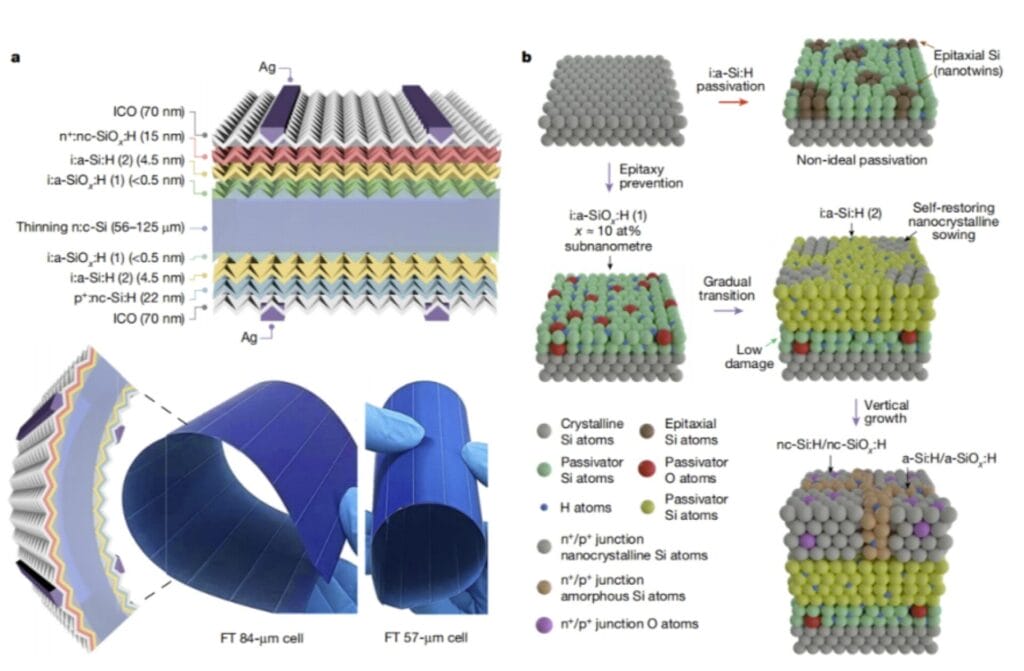
900 GW of solar manufacturing ready in China
China’s Solar PV Output In 2023 Exceeded RMB 1.7 Trillion ($236 billion)
622 GW Silicon Wafer Production; 212 GW Out Of 499 GW Modules Produced Shipped Overseas
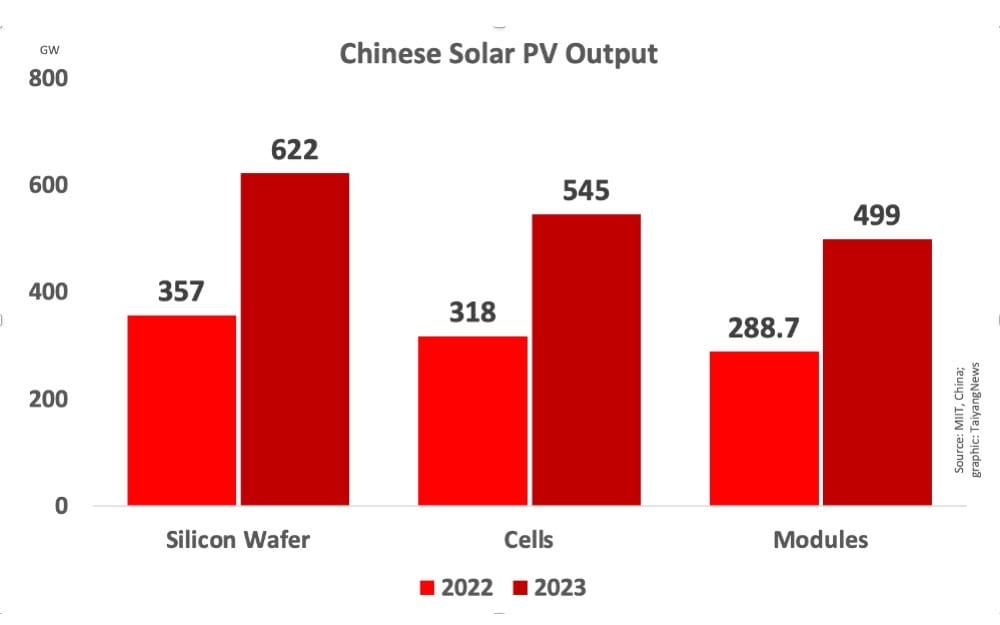
Almost half of the 499 GW of solar modules produced by local manufacturers were exported, with an increase of 37.9% annually
produced over 1.43 million tons of polysilicon last year, representing 66.9% annual increase
solar cell output went up by 64.9% to exceed 545 GW during the reported year. Only 39.3 GW of this was exported, accounting for a 65.5% annual increase.
As of 2023-end, the association counts China’s cumulative production capacity of polysilicon as exceeding 1.88 million tons, 892 GW for silicon wafers, 844 GW for cells and over 861 GW for modules.
Battery nets $1.1 million & AU$340 MWh in first 19 days
In the December quarter, Bouldercombe only operated at full tilt for the last 19 days of the years
In that short time, Bouldercombe earned about $1.1 million in revenue, and achieved a “net” margin of $341 a megawatt hour
In January we saw 74 pricing intervals greater than $1,000 a megawatt hour, and 31 pricing intervals above $10,000/MWh, which is where …. (the batteries) can make huge amounts of revenue in very short periods
we’ve got average charging prices lower than $50 a megawatt hour, so there are really good energy arbitrage market dynamics at the moment in Queensland, which the batteries are well positioned to capitalise on
The market is shifting rapidly and dynamically. We don’t see this being a regular feature in Queensland,” Francis said. “There is at least half a gigawatt of storage online next spring which will be absorbing the pricing, and shifting the pricing.”
Rapid deploy modules gets their biggest order – 70 MW to US customer
5B says the order will see it manufacture and deliver about 1400 Maverick arrays, containing more than 125,000 modules
delivered to the US from a new factory the company is building in India to help meet growing international demand
Waaree signed an agreement with 5B to build its Maverick solutions in India, with an eye to pushing down its production cost to “an economically competitive price point” and to explore opportunities for expanding production capacity
due to be operational in the second half of this year and has the potential to ramp up to gigawatt scale

Gorgeous european solar modules coming to the US
CertainTeed seems to be a distributor of SunStyle solar modules. The modules were installed on top of a Google structure in California.
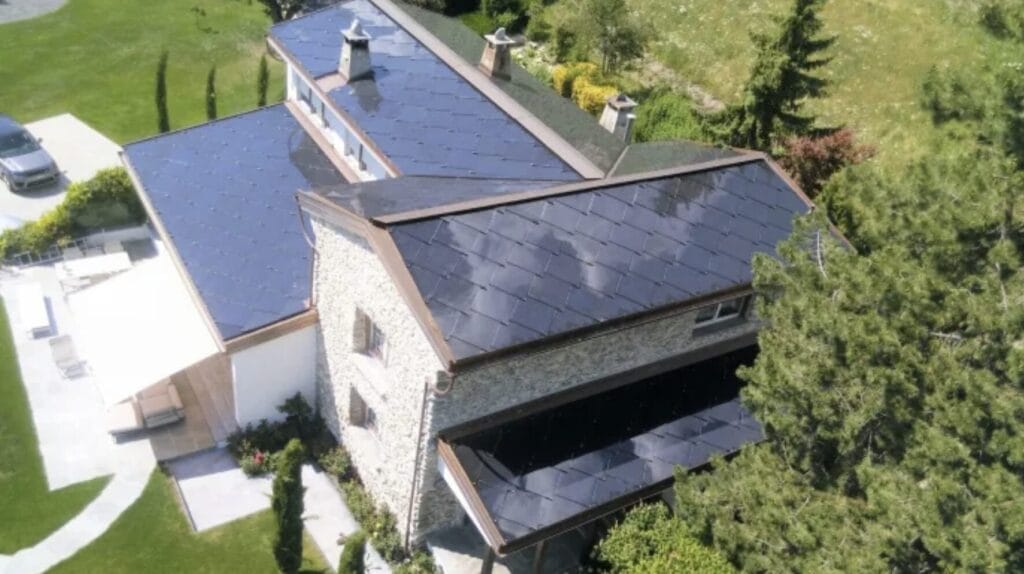
The modules were designed by a European group. SunStyle is the brand name. They’re standard solar cells that go in a regular solar panel, but in a different form factor than the mass produced units. They have a highly reflective surface, last a *long time*, and are used to cover 100% of the roof, instead of just the perfect sunlight spot.
Thieves stealing solar copper
Unidentified miscreants targeted at least 20 solar energy systems in two villages of Balluana Assembly constituency last night
stole the wires of solar systems installed in the fields of dozens of farmers, whose value is said to be worth lakhs of rupees
Thieves have cut the copper wires of the solar plants installed in the fields which used to run water motors. The value of the wire stolen from each solar system is around Rs 25,000.
Agrisolar video – how to combine food and electricity
13-minute documentary features leading voices in the agrivoltaic movement from around the country who speak to the climate solutions that result from the co-location of solar and agriculture
increased farm profitability, increased water retention, improved soil carbon, shade for farm workers, plants, and livestock, and increased resiliency for rural communities
specialty crop growers whose plants are healthier and produce higher yields because the solar panels provide protection from water loss
Inverters replacing inertia in Australia
rollout of its grid-forming inverter technology will play a critical role in the country’s switch from coal to renewables
will utilise grid forming inverters supplied by SMA
Origin Energy had issued a “notice to proceed” to the US-based Fluence for the 300 MW, 650 MWh Mortlake battery that will be built next to an existing gas generator in Victoria’s west
board had given approval for the $400 million investment, which is being supported by up to $24 million in funding from ARENA as part of its $176 million Large Scale Battery Storage Funding Round
will play a crucial role in providing stability to the local grid as more wind and solar farms are built in Victoria’s South West Renewable Energy Zone
Five of the eight projects that were successful in the special grid-forming Funding Round have been financially committed.
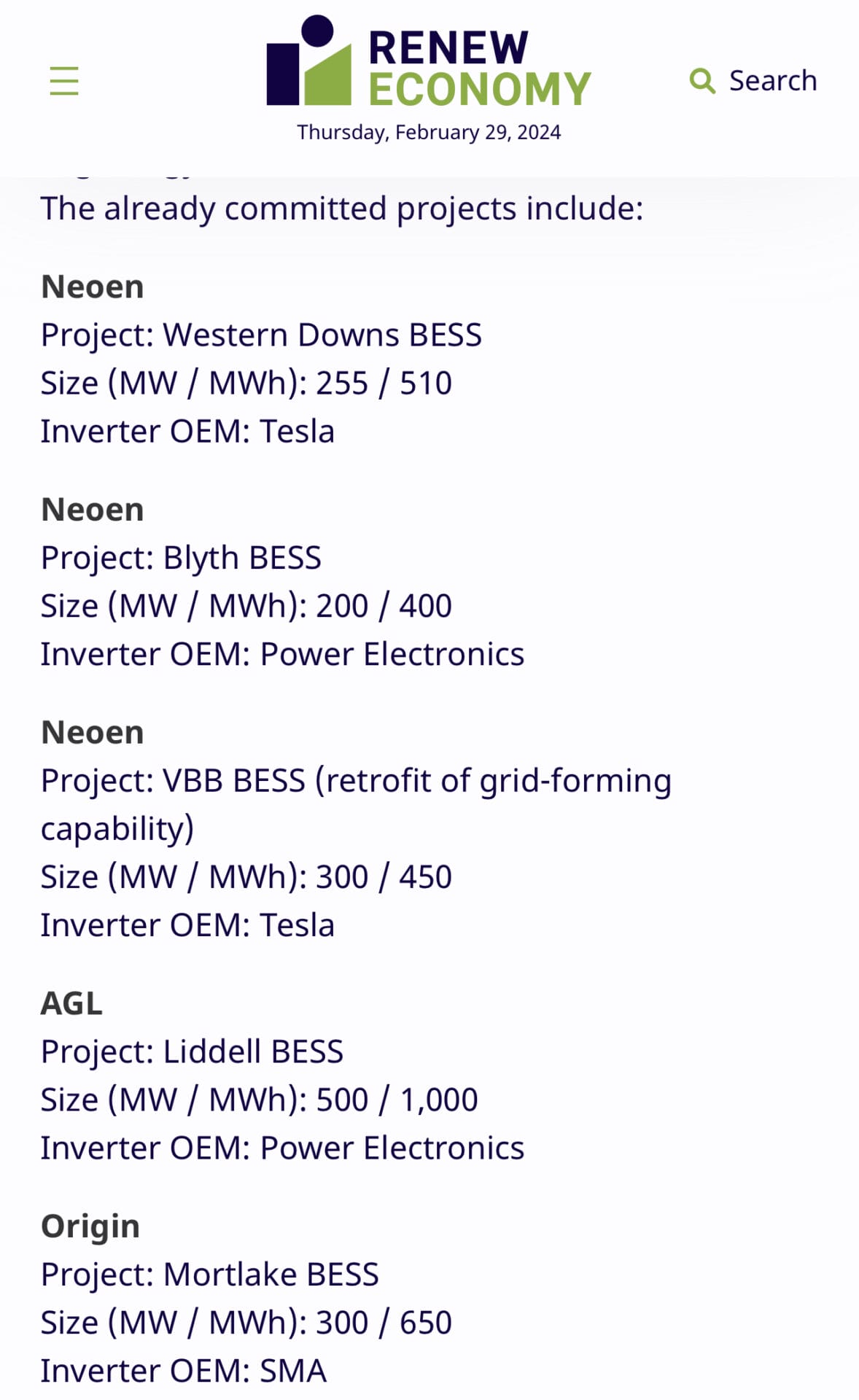
Even with down pricing, polysilicon growing
Daqo New Energy saw both production and sales of polysilicon increase by around 50% in 2023 compared with 2022
company produced 197,831 metric tons (MT) of polysilicon in 2023, up 47.8% year-on-year (YoY) from 133,812MT in 2022. YoY polysilicon sales rose 50.5% to 200,002MT in 2023, up from 132,909MT the previous year
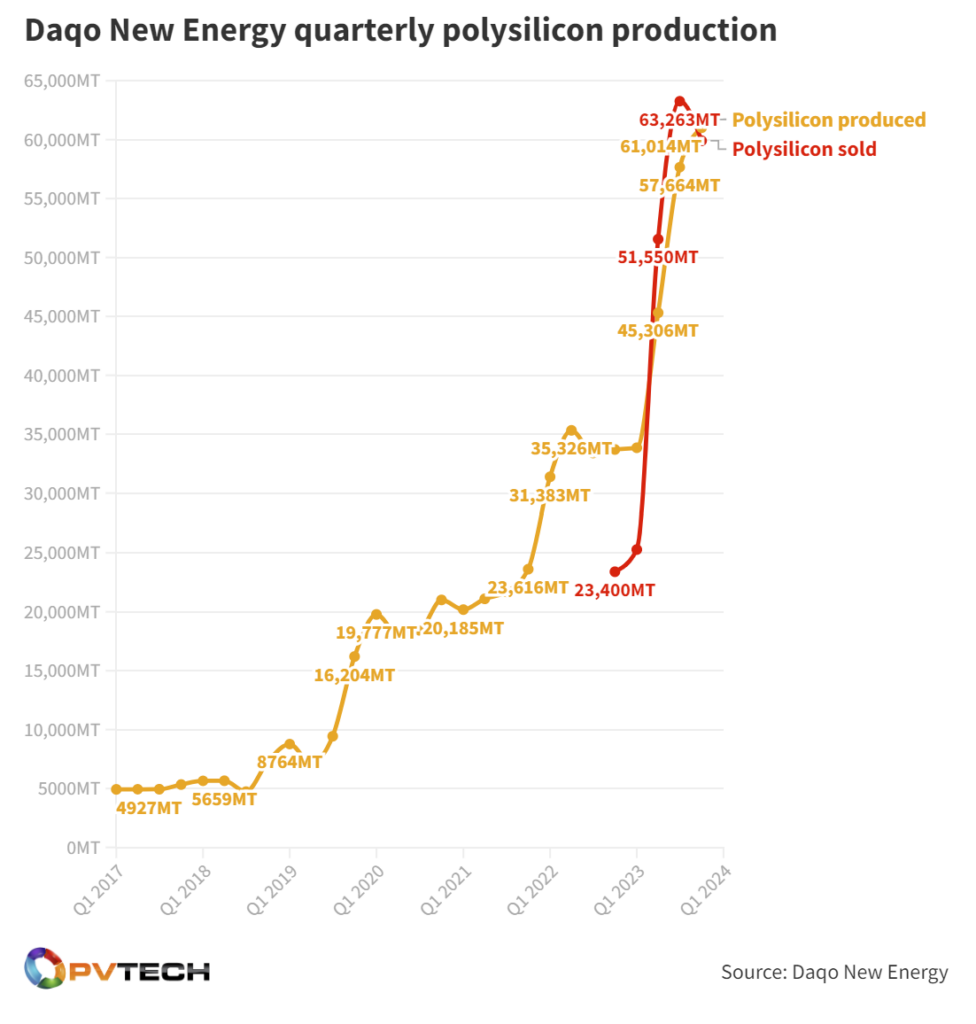
across 2023 the average selling price (ASP) of polysilicon tanked, from US$32.54 in late 2022 to US$7.97/kg in Q4 2023
“Q4 saw solid demand from customers for our high-quality n-type polysilicon,” he said. “In total, we shipped 59,392MT of polysilicon for the quarter, leaving our finished goods inventory at a very low level of less than one week of production volume across our two facilities
Looking forward to 2024, Daqo forecasts ever-greater polysilicon production: “We plan to begin initial production at our new Inner Mongolia 5B facility in Q2 2024, and as such we anticipate full year 2024 production volume to be approximately 280,000 MT to 300,000 MT, approximately 40% to 50% higher than in 2023,” Xiang Xu said.
Perovskite vapor deposition process being developed
“In Liverpool, we use a hybrid deposition method that combines the best aspects of both approaches. It is a vacuum evaporation process to deposit the inorganic components and then a second wet chemical step to convert this inorganic scaffold to the complete perovskite film. We target a throughput of several M12 wafers per h, or 40 per day,” said Borchert.
investigating the use of commercially available vacuum-based evaporation equipment to manufacture perovskite thin films and contacts layers in the fabrication of perovskite-silicon tandem cells
highest efficiency tandem cells, measuring 1 cm² or even smaller, are typically made with a wet chemical spin coating tool. “It is a good method for rapid testing but not scalable to industrial substrate sizes”
“There is a large variety of deposition methods for perovskite thin films. Some rely exclusively on wet-chemical processes, such as spin coating, blade coating and printing. Others are solvent-free evaporation processes in a vacuum, such as physical vapor deposition, or pulsed laser deposition,”
1 GW of batteries win place on UK grid
Almost 1,000MW of new-build battery assets were successful in the T-4 Capacity Market Auction (CMA) for delivery year 2027/28, which cleared yesterday (27 February) at an “all-time high” clearing price of £65/kW/year.
Noted that this “all-time high” is £2/kW/year higher than the 2024 auction clearing price “which was itself a record high at the time.”

auction round secured 42,830MW – less than 2,000MW lower than the auction’s revised target of 44GW – with 98.76% of capacity entering the auction awarded an agreement
gas was awarded the majority of capacity, securing 28,684MW (66.97%), followed by interconnectors at 6,589MW (15.38%)
Pumped storage secured the most capacity of the low-carbon technologies entered into this year’s auction, securing 1,874MW (4.38%) battery storage received 1,016MW (2.375), nuclear 959MW (2.24%), onshore wind 41.91MW (0.10%), and solar 8.2MW (0.02%).
Polysilicon supply chains shifting to SE Asia to feed US
Hemlock Semiconductor (USA), Wacker (Germany/USA) and OCI Malaysia together were able to increase their polysilicon exports to Vietnam from 18,672 MT in 2022 (+78.2%) to 33,265 MT in 2023. This growth more than compensated for the 13,918 MT they lost in business volume in China in 2023. While Hemlock and OCI achieved a net increase from their exports to both countries, Wacker’s two German polysilicon plants exhibit a negative balance: Although they were able to boost the exports to Vietnam by 7,617 MT (+151%) to 12,662 MT, their imports into China plummeted from 48,070 MT in 2022 by 12,627 MT (-26.3%) to 35,443 MT in 2023.
During the polysilicon shortage, China imported extraordinarily large volumes from Japan (2021: 15,431 MT; 2022: 6,129 MT) and Taiwan (2021: 6,899 MT; 2022: 3,480 MT). At high market prices, the Japanese solar module producer Sharp converted into cash considerable inventories, which resulted from a long-term purchase contract with Hemlock Semiconductor running through 2020.
![]()
polysilicon imports into China have fallen to the lowest level since 2011. Outside imports of polysilicon fell by 28.5% to 62,965 MT in 2023 — now less than the 64,614 MT reached in 2011.
35 GW pipeline, 14 GW vertically integrated $1.3 billion Canadian Solar factory
14 GW for wafer cutting, 14 GW for cell processing, and 14 GW for module assebly will require an investment of CNY 9.63 billion ($1.33 billion) – Canadian Solar
Aiko Solar says it will invest CNY 9.97 billion in a 10 GW facility. The company plans to build two more phases for a total of 30 GW.
China Huaneng Group said that it has resumed work on a set of 222 renewable energy initiatives, with a combined installed capacity of close to 35 GW.
Thermal solar pushed by batteries in Morocco
“With hindsight, Ouarzazate served as a testing ground for an immature CSP technology,” said another source.
Technological problems stopped all output at a 150 MW plant there for a year from summer 2021, said two of the sources.
ONEE cited problems at Noor Ouarzazate, Morocco’s best-known solar complex, as the reason for wanting MASEN to change the technology at Noor Midelt
MASEN and the grid eventually signed a power purchase agreement, but there are still discussions between MASEN and the development consortium over the technology specifications
Construction has not even started on the planned $2 billion 800 MW Noor Midelt I plant, which was meant to start operating this year, after the Energy Ministry and grid operator ONEE rejected the proposed CSP technology
after the contract was awarded ONEE and the Energy Ministry said they would only agree to buy the power if MASEN either abandoned CSP for PV or changed from thermal salt energy storage to batteries
EDF Renouvelables said Morocco had decided to restart the development in 2022 with a mix of PV, CSP and battery storage
Developing a solar thin film tandem cell at 38% efficiency
first attempt to build tandem solar cells based on CIGS and SWCNT
CGIS cell with a 2,000 nm thick absorber achieved a maximum power conversion efficiency of 23.69%
tandem cell, the scientists used a version of the CIGS cell with a 22.82% efficiency and a sample of the SWCNT device with an efficiency of 16.05% efficiency, with its combined efficiency reaching 38.91%
Solar rights law “will be back” in Virginia
earlier version of VanValkenburg’s bill would have prohibited local governments from banning solar installations outright
After pushback, the legislation was softened to say localities couldn’t limit the total amount, density or size of solar or energy storage projects as long as the overall area covered by panels within the locality remained under 4% of its land
solar industry and environmental groups argued the bill was necessary for the state to meet the requirements of the VCEA given bans and limits imposed by some local governments on solar projects
bill dead for the year after a House subcommittee voted Tuesday to carry the proposal over to 2025
Sen. Schuyler VanValkenburg, D-Richmond, said he “will be back”
Pasadena signs that green 95 percent deal
City Council unanimously voted on Monday to allow Pasadena Water and Power to enter into a $512.2 million, 20-year power contract with Southern California Public Power Authority for solar photovoltaic and battery energy storage
proposed contract aims to source renewable energy from the Bonanza Solar project, operated by Nevada-based Bonanza Solar
would bring us to that green 95 percent
contract will cover the daily delivery of a maximum of 105 megawatts of solar photovoltaic energy and up to four hours of dispatchable battery energy storage, not exceeding 55 megawatts, during a 20-year term starting Dec. 31, 2027
In 2023, PWP expanded its energy portfolio to include contracts for 25 MW geothermal energy, and one third share of a 117 MW solar energy project

High speed truck chargers deploying in California
38 port electric truck charging depot and maintenance hub is coming online to service Southern California’s ports and logistics center
located in Ontario, near Los Angeles and home to many warehouses and logistics operations to service the nearby ports
50 new electric trucks from Volvo and Daimler
chargers will be capable of speeds up to 350kW, with about 7MW of combined capacity across the 38 ports
NFI’s charger will also include solar and battery storage, with 1MW of solar and 8MWh of battery storage on-site, though both of these won’t be installed until later this year.

A million solar roofs in MA petition
Neumann urged lawmakers to enact a goal of installing the equivalent of a million solar roofs, or 10GW of solar, in Massachusetts by 2030.
As of 2022, Massachusetts has tapped 10.8 percent of its rooftop solar generation potential.
Massachusetts ranked 4th in the nation for growth of small-scale solar generation from 2012-2022 and ranked 4th in the nation for overall small-scale solar generation in 2022.
Article Link
Petition Link
40 year solar tracker
Testing indicates its Genius Tracker drive system carries an expected 40-year design life with no foreseeable maintenance requirements.
Company says the drive system’s self-contained linear actuator contributes to its expected low maintenance.
“Testing of our Genius Tracker drive system indicates that its design significantly reduces, and possibly eliminates, the need for any greasing throughout its design life. This feature improves the cost savings that our Genius Tracker product provides to customers.”
Zero Carbon solar panel factory
“Neo Green” panels were produced in factories awarded with the “Zero Carbon Factory”
Jinko said that it is the first solar PV manufacturer to receive the TÜV Rheinland certification at its ingot, wafer, cell and module manufacturing facilities.
The company said that it has integrated the use of solar, hydro and wind energy at its factories the Chinese cities of Leshan, Chuxiong and Shangrao, though it was not clear which, if any, of these facilities produced the latest Tiger Neo TOPCon modules.
The initial annual production capacity for the modules is 5GW.
Jinko was the largest volume PV module shipper in 2023.
Climate First Bank lowers solar loan rates
Climate First Bank has updated the interest rates on its 30-year Residential Solar Loan product to 7.83% and a 7.99% APR.
In 2023, the bank financed $35 million in solar loans for businesses and $83 million in solar loans for individuals. This marks a 472% increase in solar business loans and a 367% increase in consumer loans year over year.
Meta datacenter solar project rejected by town
Commissioners Erika Sugarmon, David Bradford Jr., Shante Avant, Henri Brooks and Mickell Lowery voted in favor of the solar project. Commissioners Amber Mills, Edmund Ford Jr., Mick Wright and Britney Thornton voted against it.
Commissioners Charlie Caswell and Miska Clay Bibbs abstained from the vote, and Commissioner Brandon Morrison recused herself due to her family having an interest in solar panels in another county. Commissioner Michael Whaley was not present at Monday’s meeting.
The neighbors’ concerns ranged from runoff that could cause erosion to the land, RWE’s lack of concern for wildlife in the area, and chiefly, that the solar panels will be an eyesore in their rural neighborhood plummeting home values.
At least 15% of counties in the U.S. have effectively halted new utility-scale wind, solar, or both, USA TODAY found. These limits come through outright bans, moratoriums, construction impediments and other conditions that make green energy difficult to build.
The Graceland Solar Project is part of TVA’s Green Invest partnership with RWE and Meta. The 150-megawatt solar facility will allocate 100 megawatts to Meta for use at its data center in Gallatin. The total megawatts produced are equivalent to powering approximately 24,000 households, McNeely said. The other 40 megawatts will be used for redundancy within TVA’s system.
Though the solar project said they plan to place solar panels on about 600 acres of land, but has acquired over 1,500 acres for the project.
Though the resolution to allow the solar farm to be built was denied, an attorney Monday night said that the company could sue the county to reverse the commission’s decision.
Large wind and solar projects getting local pushback, New York still open
New York state has 62 counties but 933 towns. Zoning is typically done through towns rather than at the county level.
Among 62 counties, 0 (0%) have significant impediments to wind or solar.
In 2009, North Carolina banned 23 counties from new wind projects. In 2014, Kentucky made it effectively impossible to build new turbines in all 120 of its counties, and Connecticut followed suit in its eight counties. Vermont did the same across its 14 counties in 2017. Tennessee stopped new wind projects in all but four of its 95 counties a year later.

EPC crunch might limit 2024 utility scale solar growth
He guesses that the top 10 EPCs represent 15-18GW of overall capacity and 80% of the EPC industry, suggesting the overall EPC capability could be just 21GW.
Our contact shared that “supply chain issues continue to push things to the right. A lot of projects are pushing to the right. [He doesn’t think] 2024 is going to be +30% y/y. 2024 could flat to up 5% only.”
EPCs in the recent past “took on crazy work in past years” and now the [EPC] focus is on improving the bottom line
Recently, we wrote here that EPC capacity could be a new bottleneck. We asked our contact about EPC bottlenecks and what the latest dynamics are. Some EPCs have exited the business, such as Ames Construction, which represented 1-1.5GW of annual capacity. There were credible Tier 1 EPCs that took on projects that were losing money, thinking they “could turn it around but labor quality has not been good and margins are bad.”
US solar up 75% – 35 GW new capacity deployed in 2023
The US utility-scale solar sector added 23.7GW of new capacity, alongside 11.6GW of capacity in the commercial and industrial and residential rooftop sectors.
35.3GW of new solar capacity in 2023
42GW of new renewable power generation capacity, alongside 35MW of new biomass and waste-to-energy capacity
new wind installations, which accounted for around 7GW of new capacity
China overtook the US to become the largest storage market in the world, despite developers commissioning 7.5GW of new battery storage facilities in the US
In the first 11 months of 2023, the US imported over 50GW of PV modules, an increase of 144% over the same period in 2022
Analysts from BloombergNEF note that the US has US$469 billion in “overcapacity investment” planned over the next three years
India’s largest solar+battery facility – 100 MW Solar+40 MW battery
100 MW AC (155.02 MW peak DC) solar power with 40 MW/120 MWh BESS
solar power would be purchased by Chhattisgarh State Power Distribution Co. Ltd (CSPDCL) to meet the energy demand of the state during peak hour
Tata Power Solar Systems is the EPC and 10-year operation and maintenance support provider.
Texas (45%) & California (36%) deploying 80% of US’ 2024 utility batteries
Developers are expected to complete 6.4 gigawatts of new grid battery capacity in Texas this year, according to the federal Energy Information Administration. That’s more than double the 5.6 gigawatts of battery capacity it ended 2023 with.
much battery capacity as the entire United States built last year
The projection outpaces the 5.2 gigawatts set to come online in California.
The U.S. is slated to add 14.3 gigawatts of battery storage overall this year.
TX – 45% of projected 2024 capacity
CA – 36%
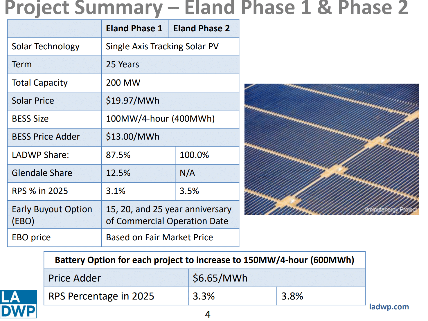
60% capacity factor solar plants get $1 billion in funding
200 MWac
374 MWdc solar installation coupled with 150 MW/600 MWh of energy storage, is currently in the early stages of construction and is slated to commence operations in the first quarter of 2025
announced the procurement of over $1 billion in aggregate financing commitments for its Eland 2 Solar-plus-Storage Project in Kern County, California.
Tesla’s Megapack 2 XL battery system
SOLV Energy, based in San Diego, serves as the project’s engineering, procurement, and construction (EPC) contractor
Back in September 2019, 8Minute Solar said their Eland Solar & Storage facility would have a 60% capacity factor.
In 2022, he reiterated this value in an interview:
We also created the Eland Solar & Storage Center, the first large-scale solar power plant with a 60% capacity factor — twice the natural capacity factor of the sun.
We found optimal economics hovered at around a 60% capacity factor and designed a power plant to meet the customer’s needs.
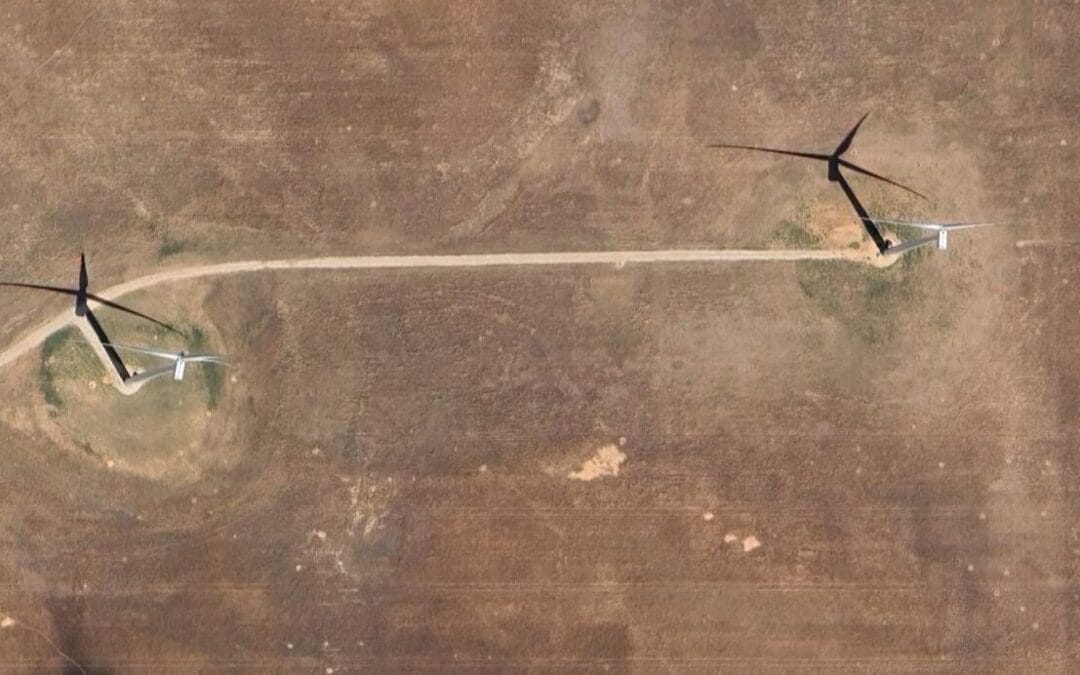
82% IX capacity factor, ~250 MWix/750 MWac/1,575 MWp wind-solar-storage facility getting closer
Skeleton Creek Energy Center
2020, the project’s wind energy portion was completed and is operational, with a capability of generating up to 225 megawatts
solar and storage that could generate up to 250 megawatts of local solar energy to pair with a 252-megawatt, four-hour battery storage system
solar and battery storage portion of the project will bring an estimated $65 million in additional tax revenue
likely will break ground this year and open the facility in 2025
From prior reporting,
The Skeleton Creek combined project is expected to generate about 1.8 million megawatt hours of electricity annually – suggested a mixed AC capacity factor of 41%.
That’s at 500 MWac – but if we’re looking at all three projects outputting from the same general area, it turns into a potential 82% capacity factor.
The U.S. Department of Energy defines the Skeleton Creek Energy Center in its 860M form as a multi-powered 250 MWac wind facility.
Also, date slipped…
Skeleton Creek Solar – 250 MW of solar energy, expected to begin operations by the end of 2023
Skeleton Creek Storage – 200 MW, 4-hour battery energy storage project, expected to begin operations by the end of 2023
Project total power capacities:
250 MW wind generators (or maybe 225 MW)
250 MWac / 325 MWdc est solar
250 MW / 1,000 MWh battery
So, 250 MWac interconnection, 750 MW energy delivery potential, and 1,575 MW of hardware.
50 MW project rejected on technicality
Local authorities are only permitted to give permission to solar power stations up to a certain size (50MW) – and the judge agreed that the Burnhope plans exceeded that size.
Confusing to me because Lighthouse BP knows the local rules (50 MW allowed), 92 hectares is just about enough for 50 MW, and a prior article suggested the site was 49.9 MW.
I assume the project will be submitted again.
Maybe there’s a battery there…I’ll follow up.

50% battery price drop knocks $840 off EVs, more coming
Several automakers will switch to the CATL cell in mid-2024 at a price not exceeding RMB 0.4/Wh ($56/kWh), according to the report.
The average price of square LFP cells at the same time last year (late June/July) was around RMB 0.8 to RMB 0.9 per Wh. By August 2023, that price was reduced to around RMB 0.6 per Wh.
Each RMB 0.1/Wh ($14/kWh) drop in the price of the battery cells means that a model equipped with a 60-kWh battery pack can save about RMB 6,000 ($840) in costs, the 36kr report noted.
Power batteries have gone from being in tight supply to being in oversupply in a year’s time, and prices are now gradually dropping towards RMB 0.3/Wh, the report said.
Leapmotor’s Cao even believes that the price of battery cells could drop to RMB 0.32/Wh.
Prices were at “RMB 0.9 to 0.8” last June-July, they’re now at “below RMB 0.5”. That’s an 8 month 40-46% price drop.
Buyer suggests prices could hit RMB 0.32 by same June/July – which would be a 60-64% price drop in twelve months.
With increasing technology embedded.
Solar module warranty claims 101
The first is simple: Read the warranty exclusions. When manufacturers face warranty claims, they have two practical options: 1) honor the warranty; or 2) blame everything other than the warranted product for the problem.
Second, system owners also need to organize their essential documentation. This means not only the contract, but also all exhibits to the contract, plus any proposals, purchase orders or documents referenced in the contract even if not specifically made an exhibit.
Third, system owners should also review the O&M plan. Experienced operators might have a great plan in place already, but if it doesn’t consider the specific requirements from the module manufacturer, that gap between what one typically does and what that manufacturer recommends might well be a legitimate basis for a denied warranty claim.
Document that the plan is actually being implemented — make sure, for example, that if a manufacturer recommends yearly re-torquing of bolts on the slew drive, not only is re-torquing done, but it’s also documented as being completed on schedule and according to the manufacturer’s specifications.
Other considerations:
• Plan to pursue warranty claims as quickly as possible. Obviously, this will need to be done while still following any mandated warranty procedures and not spoliating any evidence, but a manufacturer that unnecessarily delays and asks for more and more information to “better assess this claim” is unlikely to do an about-face and honor the warranty claim many months into the process. They either value their customer and want more business in the future (and will therefore meaningfully assess and honor valid warranty claims) or they don’t.
• What are the warranties on all the key systems? Do the modules, tracking system and inverters all have different length warranties? If they don’t all have the same warranty duration, has this been appropriately priced into O&M budgets?
• Who actually holds the warranty? Did the EPC contractor purchase everything? Has the warranty been appropriately assigned, or will the EPC contractor stand in the shoes of the manufacturer? Injecting more parties into the process is going to make things worse — particularly if the remedies available to the owner are not perfectly back-to-back.
Free used solar panels in Orlando
808 partly used solar panels belonging to the county, each 2.6 feet by 5.2 feet, 33 pounds and rated at 175 watts, are to be handed out from February 26 through March 31 at no charge to residents, businesses and whoever else wants them – in Orlando, Florida.
To sign up to get panels, go to ideasforus.org/solargiveaway/

installed nearly 15 years ago in a solar array rated to generate a peak of 1 megawatt of electricity.
rooftop system installed in 2009 for $7 million was paid for as a demonstration project by the county, Orlando Utilities Commission and the state of Florida
a new solar system will be installed next year with the same number of panels and within the same footprint, but putting out twice as much power and costing $2 million less than the original system
Roselund (CEA) sees 35 GW module capacity in US at end of ‘24
Annual module capacity in the US is expected to reach 35GW by the end of the year.
Last year, large-scale PV module assembly plants from eight manufacturers, representing over 20GW of new capacity, received equipment.
A truly awesome volume of US PV module factory announcements has followed the passage of the IRA — more than 140 gigawatts of annual capacity at last count.
Top renewable company hates renewables
United States’ top developer of green energy has spent nearly six years undermining a clean power project.
NextEra’s campaign has delayed the power line’s construction for almost two years.
“It just shows you that these companies are not fundamentally allied with the climate movement, not fundamentally on the side of climate progress,” said Leah Stokes.
NextEra’s national fleet of wind and solar farms generate more renewable electricity than any other company in the country.
‘Disturbing evidence’
groups were directed by consultants working on behalf of NextEra
One of the groups, Alpine Initiatives, failed to register as a political action committee before making a $150,000 contribution to the Maine Democratic Party, a move that ethics officials said masked the source of payment from the public. The contribution was an attempt to ingratiate the consultants to Democratic officials as they looked for allies in their fight against the power line, the commission said.
second group led by NextEra-hired consultants, $50,000 for failing to register as a ballot committee after it hired field workers to gather signatures needed to place a question on the 2020 ballot that asked voters to block the line
NextEra spent more than $20 million to support this question, while Avangrid and Hydro-Québec, the Canadian utility that would send power to New England, put up more than $50 million in an attempt to defeat it.
Argued that the client would face “reputational harm” if the consent agreement identified it.
NextEra is the most valuable publicly traded power company in the country, with a market capitalization around $117 billion, and has pledged to achieve “real zero” emissions by eliminating carbon dioxide pollution from its operations by 2045.
Australia investing half a billion in battery supply chain
Queensland, AU has unveiled a five-year, $571 million Battery Industry Strategy, setting out a plan to establish a battery supply chain in the state, spanning from materials supply to advanced manufacturing, associated technologies and recycling.
state is home to local zinc-bromide flow battery manufacturer Redflow
3,200% rooftop solar growth projection wrong (or too soon)
The US rooftop solar industry had room to grow by more than 3,200%, he said, leaving companies like his primed to reap the rewards.
The company, which primarily sells rooftop systems, fired workers to cut costs and had to raise $200 million to ease a cash crunch.
75% plunge in shares over the past year, Faricy’s predecessor returned as executive chair this week.
The company in October said it had overstated the value of components of microinverters — small devices that help solar systems produce more energy — and needed to restate financial statements for 2022 and the first and second quarters of 2023.
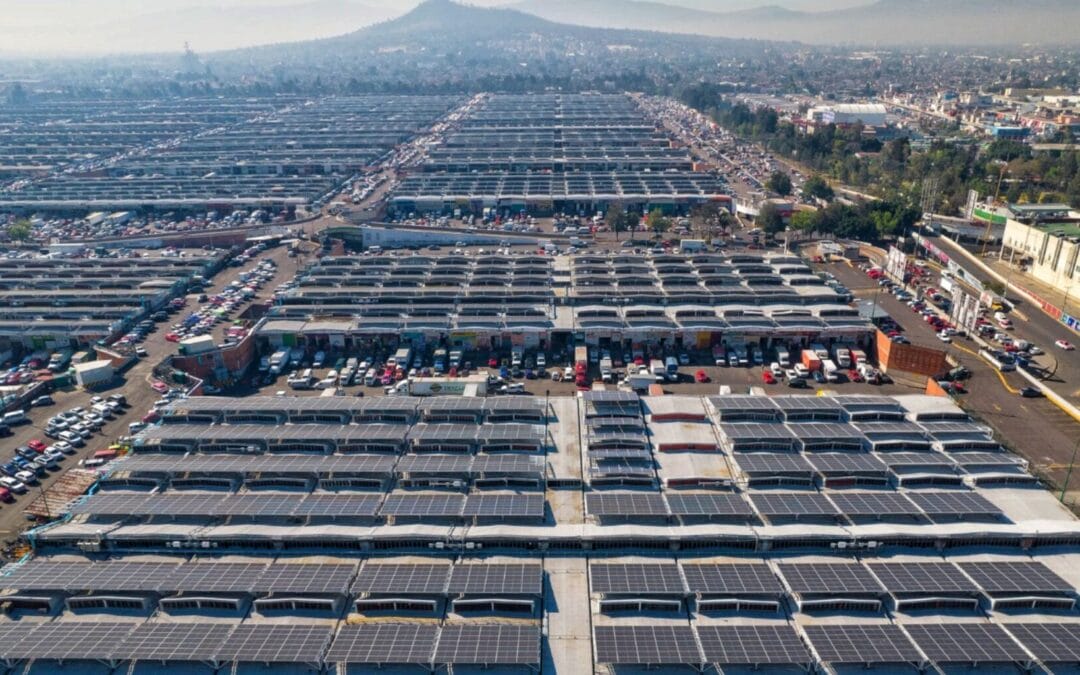
World’s largest (?) rooftop solar plant
Mexico City gets 18 MW rooftop solar project.
32,000 solar panels installed over 21 hectares (52 acres) above the capital’s Central de Abasto (CEDA) have 18 megawatts of capacity, and will generate up to 25 gigawatt hours (GWh) of renewable electricity per year.
Annual savings of 3.5 million pesos (US $205,300) in the payment of CEDA’s electrical bills.

On the rooftops of Mexico City’s massive public wholesale market, the Central de Abasto (CEDA).
Plant cost 600 million pesos (US $35.2 million) to build.
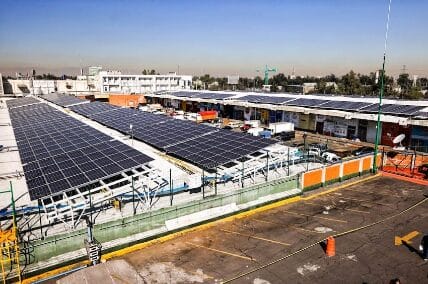
Island town seeking solar plus storage resilience
Chilmark could pursue three levels of resiliency
most resiliency would be achieved with a full microgrid. This involves powering the town hall, fire, and EMS buildings with solar energy, adding a battery, and connecting all of these features in a microgrid.
could also choose to simply outfit the buildings for solar energy and add a battery. Adding a battery for the buildings could lower electricity costs for solar energy, and would add resilience for outages of up to 48 hours
path of least resiliency, which would provide one to four hours of backup power in the event of a power outage.
With a battery, 15 diesel generators down-Island, used during peaks in power, could also be discontinued.
Residential VPP PPA
Residential finance company sees savings due to VPP
finance package for residential solar-plus-storage, claiming its enhanced terms are directly tied to the benefits derived from virtual power plants (VPP).
Solrite Energy’s PPA is now accessible to homeowners in California, Puerto Rico and Texas. The company is planning expansions into New York, New England and Hawaii later this year
For example, in Massachusetts and Rhode Island, the National Grid’s ConnectedSolutions program seeks to pay energy storage owners up to $400/kW during high grid demand events in Rhode Island, and $225 in Massachusetts. Similarly, Eversource, another major utility in Massachusetts, offers a similar program.